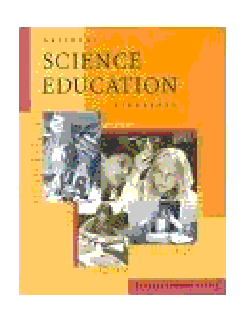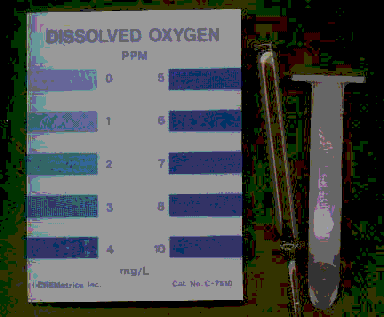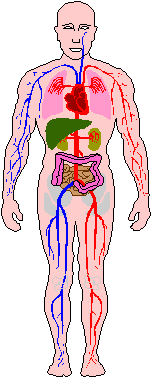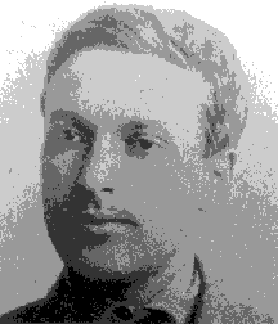Introduction
Chapter 1
Syllabus Helper
To help you integrate The Art of Science Teaching into your syllabus, the syllabus helper's chart highlights the key pedagogical tools and activities for the chapter. Chapter 1 is an overview of science teaching, and as such you might look at it as a reconnaissance. There are many opportunities in this chapter for prospective and professional teachers to think about science education, and identify their current ideas on various topics. It's designed to build interest, and to build upon the prior-experiences of your students.
| Pedagogical Tools | Highlights/Content | Notes |
|
Initial Case to Consider |
First Year Teacher's Dilemma |
Designed to involve the reader in some aspect of the chapter. In this case the case a new teacher questions the department head's philosophy and thinks science should be more application oriented. A great first activity for students to discuss in groups of 3 or 4, with later reporting to the whole class. |
|
Invitations to Inquiry |
Preview questions on the content of the chapter. |
Useful as advance organizers |
|
Inquiry Activities |
1.1. Exploring your Initial Ideas About Science Teaching 1.2. Teaching to Learn: Reflective Teaching 1.3. Surveying Students Views of Science 1.4. The Student is First |
Using problem situations for the 5 core ideas introduced in the text, students compare their initial conceptions with each other Using a microteaching format students plan lessons based on a listd of science objectives. Writing an essay, drawing a scientist, answering a questionnaire are used to explore students views and understanding of science. Using 5 vignettes (which are located on the Companion Website) of teens, students discuss the characteristics and potential learning problems and how to mitigate them. |
|
Science Teachers Talk |
Teachers responded to this interview question: What do you like most about science teaching? |
We interviewed more than 20 science teachers from five different countries (Australia, Botswana, Canada, Russian and USA) for this feature. You will find a science teachers talk section in the Companion Site correlated with each chapter. In this chapter, the science teacher talk piece is introduced on page 9. We've listed all of the teachers who were interviewed (in the preface), and you'll find the first question and discussion about what experienced teachers like most about science teaching. A great activity is to have small groups of students tell each other what they hope to get out of a career in science teaching, or if you are working with experienced teachers, ask them the question about what they like most. Then have them read what the interviewed teachers had to say. |
|
Cases to Consider |
The Student Who Just Can't Relate to This "Physics Stuff." Located on the Companion Website. |
Do some students relate less to physics than biology? This case study will lead to discussions of relevancy and science teaching. |
|
Science Education Literature |
Science is Not Words by Richard Feynman, located in Gazette |
I've used this article (see page 30) as a reading after the first class or session. It sparks students curiosity about the nature of science and science teaching, and was written by Nobel Prize scientist. Initially a speech given to science teachers, it was then published in The Physics Teacher. |
|
Problems and Extensions |
Sample: What are your current conceptions of science teaching? What, in your opinion, does a person need to know in order to be a good science teacher? |
Problems and extensions are enrichment activities that can foster reflection, and creative and critical thinking. You will find five to ten problems and extensions in each Science Teacher Gazette. |
|
Readings |
Located in the Gazette |
Articles and some books related to the chapter's content. |
|
On the Web |
Located in the Gazette |
A short list of websites related to the chapter's content. |
Agenda Strategies
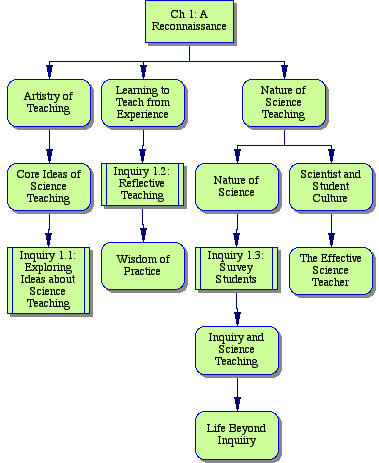
Whether you are teaching a full semester course, a workshop for teachers extending over a term, or a summer institute, your syllabus will be turned into individual lesson plans. Not knowing the length of your teaching sessions, we've described several "agenda building activities" that you can pick and choose from to build your lessons. These can be construed as classroom or online activities, or problem solving projects. Each is based on The Art of Teaching Science, 2nd Edition.
Note: We've developed a Powerpoint Presentation for this chapter (and all of the others) that you can access at the Companion Site at Routledge. Together with these Agenda Strategies and Syllabus Helpers, you will have powerful resources to create a science education course or workshop based on The Art of Teaching Science. We wish you the best in your endeavors. You can visit us online at our Weblog: artofteachingscience.org
SECTION 1: A RECONNAISSANCE
EEEP #1---The Penny and a Glass of water. We like to start class sessions, especially at the beginning of a course, with an EEEP (Exciting Example of Everyday Experience). EEEP's are similar to demonstrations or discrepent events that you may be already be using. After students have arrived, and settled in, conduct the following EEEP.
Present a full glass of water to the students. Ask them to predict how many pennies can be carefully dropped into the full glass of water. Note the students' predictions. If you want to take some extra time, have teams of students work together to talk through their predictions. In front of the entire class, drop one penny at a time into the glass of water. (Note: If you hold the penny so it slides into the water vertically, as opposed to on one of its sides, then you ought to be able to drop between 20 - 50 pennies in a full glass of water.) Invite the students to work in small teams to illustrate and describe in words their explanation of this EEEP.
You see the results of three different high school chemistry students on this EEEP. Note the drawing and the related very descriptions and labeling. The teacher used an EEEP activity sheet that individual or small groups of students used to process their thinking during an EEEP. This is a powerful way to extend the value of a demonstration so that it becomes beoth a cooperative learning activity, and a constructivist-oriented activity as well.
A First Year Teacher's Dilemma--Initial Case to Consider
"Cases to Consider" in The Art of Teaching Science are problem solving dilemmas based on actual and fictional events about science teaching. W've written one case study to introduce each chapter, and you will find addtional cases in the Art of Teaching Science Companion Website.
Have your students read the case (p. 3). In teams of two or three have students discuss what they would do if they were in the situation, and be prepared to share a consensus opinion with the class. This, and other cases in the book can also be used for online discussions using a bulletiin board. If you do not have access to a bulletin board, go to Nicenet to set one up as part of a course.
Inquiry 1.1. Exploring Your Initial Ideas About Science Teaching
This is the first of 34 Inquiry Activities in the text. This one is a powerful one because it will give your students an opportunity to express their opinions (prior knowledge) on the core ideas upon which The Art of Teaching Science is structured.
In this activity, your students will have a chance to think and talk about their initial ideas of core ideas of science education. We do not recommend that you try and "cover" all of the ideas presented in the activity. Turn it into a game whereby small teams of students draw a card (have them make decks of cards each with the name of a theme on it), and then use the information in Table 1.1 to carry on a discussion of that theme. Each team ought to be able to discuss one or two of the themes. Each theme has a description of a problem situation as well as questions to help the students assess their initial conception on the problem presented. If you form groups of 4 students, give them 10 minutes to process each theme that they select. At the end of the rounds of discussion, bring the class together to discuss their results. Use the questions in the Minds-On Strategies section of the activity on to process the activity.
Inquiry 1.2. Teaching to Learn: Reflective Teaching
In this inquiry, students will prepare a "microteach" lesson and teach it to a small group of peers. We've provided a table of science content objectives (Table 1.2) from which students will select an objective and use it to design a lesson. We've also provided several links in the table which stdudents can use to gather relevant information about the content goal.
Inquiry and Science Teaching
This is a brief introduction to the notion of inquiry and science teaching. It will be revisted throughout the book when we explore learning theory (Chapter 7), models of teaching (Chapter 8), as well as in Part 4 strategies of science teaching.
Also, this section on teaching and inquiry should be explored in the context of one's idea of the nature of science, and the role inquiry plays in science.
An approach to take for this section is to ask the students to read Richard P. Feynman's article, Science is Not Words (see the Gazette). We have had great sucess helping students reflect not only on what is science, but what is science teaching by having them read Feynman's article. Once the students have a chance to discuss the article, you might present some of the ideas in the section on science teaching and inquiry, especially the characteristics of inquiry, and inquiry in the classroom.
Life Beyond Inquiry
We developed this section to open the door to other approaches to teaching and learning, and to help readers see how these approaches can be used together. Thus, you might have students compare and contrast these 'beyond inquiry' approaches: direct/interactive teaching, cooperative learning and constructivist teaching.
Two Cultures?
Does the scientist and the student represent two different cultures? This discussion helps us reflect on some differences between scientists (as researchers, professors, project directors) and students (as early adolescent and teens). You might ask students to work in small teams, and make two lists---list 1--the characteristics of scientists; list 2--the characteristics of adolscent students. Have them compare their results to some of the points made in the chapter. This discussion will be a great lead in to Inquiry 1.4 The Student is First.
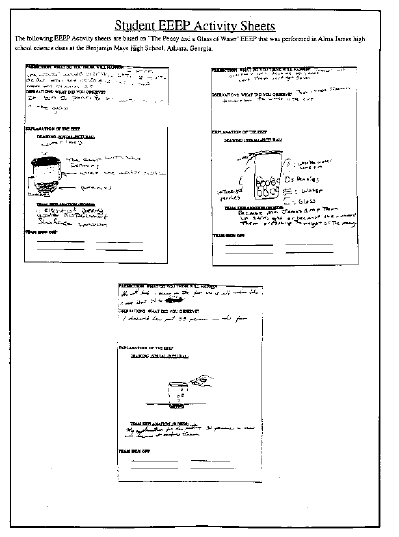
The Artistry of Teaching
There is a brief discussion of the Artistry of Teaching on pp. 4-5. You might want to have the students, in small groups, make a list of examples that support the notion that there is an artistry of teaching. After groups report on their results, you might discuss the aspects of artistry based on the work of J. Bronowski and Eliot Eisner.
What is Science?
The section on What is Science is designed to get students to think about their conceptions of science by reading about vignettes from the history of science and then discussing their views and opinions. Brief discussions are presented abouit "what is science," "science and courage," "science, problem solving, and the human mind," "science and human values," and "science and democracy." Two of the stories that are described (Frances Oldman Kelsey's work at the FDA, and issues surrounding the discovery of the structue of DNA by Watson and Crick) provide specific cases for class or online discussion.
Inquiry 1.3: Surveying Students' Views of Science
This inquiry should be combined with the discussion of What is Science? on pp. 13-17. In this inquiry, three methods are described that could be used to gather information on what are individuals' (school-age students, peers, or other adults) views of science. The first method is an essay, the second is making a drawing, and the third involves the use of a questionnaire. We have used the drawing of a scientist as a first-day-of-class activity. You should obtain a large box of crayons, and a pack of drawing paper for the activity. Have students make a drawing of their conception of a scientist at work. After the drawings have been completed, you can conduct a class discussion having students show their art work, but explain the results. You might also have students evaluate their drawing by using the Draw-A Scientist rubric.
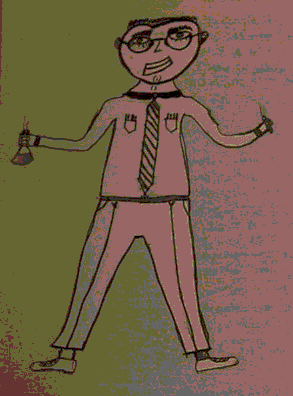
SECTION 2: SCIENCE TEACHER GAZETTE
Interview a Science Teacher: Wisdom of Practice
We've included the questions we used to interview the teachers that you and your students will meet in the Science Teacher Talk sections of the Companion Website.
Problems and Extensions
You might look at problem #4, and have students make use of their knowledge to discuss the nature of science and compare their views to Bronowski, Feynman, Randall, Polyani, and Sagan.
Other Stuff- On the Companion Site
- Chapter Powerpoint Presentation
- Science Teachers Talk: What makes teaching a rewarding career? What advice do you have for beginning teachers?
- Case to Consider: The student who can't relate to this physics stuff.
- Website Links
Chapter 2
Syllabus Helper
This chapter explores the theme science for all from four interrelated perspectives: global thinking, multicultural education, feminist perspectives, and exceptional children and youth. Your students should be encouraged to return to this chapter from time to time to review these perspectives.
| Pedagogical Tool | Highlights/Content | Notes |
|
Initial Case to Consider |
All can learn, but will they? |
Students are asked to compare and contrast their own views with those of teacher in the case. |
|
Invitations to Inquiry |
Focus questions for the chapter. |
A key inquiry for the chapter is What is the implication of the theme 'science for all'? And is it a reality in today's schools? If not, what needs to be done to make it a reality. |
|
Inquiry Activities |
Inquiry 2.1 Exploring Global Thinking Inquiry 2.2 Investigating Images Portrayed in Science Teaching Materials Inquiry 2.3 Finding Out About Science Programs for the Exceptional Students |
"Global" teams analyze problems facing the Earth A checklist is used to analyze images in science textbooks Websites are used to explore exceptional programs |
|
Science Teachers Talk |
Teachers explore the question: How do you accommodate students with exceptional needs, such as the gifted and talented, hearing impaired, visually impaired, mentally retarted, students with learning disabilities, behavioral disorders, or potential dropouts? |
Located on the Companion Site, teachers discuss how they deal with these topics. |
|
Case Studies |
A case is discussed that focuses on how standards and attitudes are employed with ethnic minority and low-income persons. |
This is a good case to integrate into the section in the text on multicultural education. |
|
Science Education Literature |
There is one piece of literature in the Science Teacher Gazette and available on the Companion Website: Our Apartheid: The Imperative of Multiculturalism in Science Education by Randy Moore |
Moore's article is poignant in the context of achieving "Science for All." |
|
Research Matters |
Encouraging Girls in Science Courses and Careers by Jane Butler Kahle located on the Companion Website. |
This is one of Kahle's earliest research papers that appeared in the NARST Research Matters columns. It outlines characteristics of teaching programs that successfully encouraged girls in science. |
|
Problems and Extensions |
Sample: Find out who the following scientists were and what their contributions were to science. Design a science lesson in which one of the scientists listed plays an integral part in the lesson. |
Take a look at the other problems and extensions. They can be used for interesting class discusions or small group activities. |
|
Readings |
Here you will find an interesting mix of articles and books for further study on topics such as the inclusive classroom, feminist science education, equity and science education, and differentiated instruction. |
|
|
On the Web |
A collection of sites to explore online knowledge about the theme science for all. |
Agenda Strategies
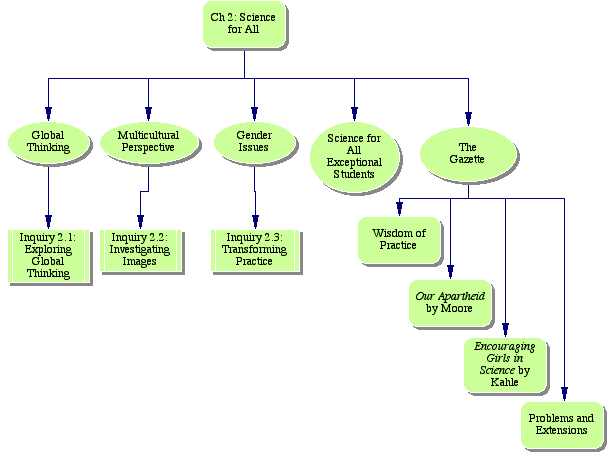
In this chapter, we will explore the theme Science for All (SFA) from four interrelated perspectives: global thinking, multicultural science education, feminist perspectives, and exceptional children and youth. The issues discussed in this chapter will play a pivotal role in our students' development as a teacher. Returning to this chapter from time to time to review and extend will be a valuable experience.
SECTION 1: SCIENCE FOR ALL
We recommend that you download the Powerpoint presentation for this chapter, and use it as an overview for yourself, and note the slides and activities that we've built into the presentation that you might want to use with your students. Again, we want to reemphasise that the we designed the Powerpoints for you and your students to use with the chapter.
Initial Case Study: All Students Can Learn, but Will They?
The initial case to consider focuses teacher perceptions of students willingness and ability to learn. Use the case to have your students compare and contrast their own views on this topic.
Theme 1: Global Thinking
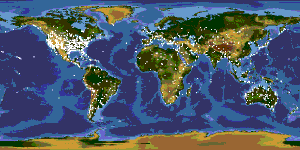
A powerful way to introduce your students to global thinking is to do Inquiry Activity 2.1. After the activity is completed, use Table 2.1 to introduce the core ideas associated with global thinking. Note that six elements are identified. An interesting way to explore the chart is to assign a different element to six groups in your class. Ask the group to describe a lesson whose goal is help middle or high school students apply the element in a community setting.
Inquiry Activity 2.1: Exploring Global Thinking
We've used this activity for a number of years, and in fact have used it with secondary students from different nations (Australia, Russia, Spain and US). The essence of the activity is to have a group of students "rank order" a list of global environmental problems. To give the activity more of a global perspective, have individual teams role play citizens from a different country (e.g. Australia, Chile, China, Ghana, Japan, Russia, Turkey, USA). So, when they rank order the problems, they must try and do it from the framework of the country they are representing. Use the Minds-On Strategies to process the results of each group.
In preparation for the activity, make photocopies of the Global Problem Cards (which you will find in the text), and provide each team with a set of the cards.
Theme 2: Multicultural Perspective
A powerful way to introduce this theme is to make use of the article by Randy Moore (Our Apartheid: The Imperative of Multiculturalism in Science Education. As Moore points out, "Despite decades-long proclamations about the importance of 'science for all,' our educational system has produced a scientific apartheid." What do students think about the issue that Moore has brought to the surface? Ask the students to explore Moore's article and identify three or four things to do to make science curricula more accessible.
Talent Development Approach
Introduce your students to the Talent Development Approach developed at Howard University and Johns Hopkins University. Have your students visit their website to see how the principles of the TDA are put into practice.
Effective Teaching Practices in Multicultural Context
Have your students explore the research-based teaching practices identified by Padron, Waxman and Rivera. Assign a different practice to each group in your class, and ask them to identify how they would integate the practice into a lesson on a concept in biology (their choice).
Inquiry Activity 2.2: Investigating Images Portrayed in Science Teaching Materials
You will need to gather together a collection of science textbooks (elementary, middle and high school). Have students work in teams to evaluate the images of science and people as portrayed in the book using the Multicultural Textbook Evaluation Checklist. Have students report to each other, and then have them identify some results across the textbooks that they examined.
Theme 3: Gender Issues
Gender issues are introduced here, and in the chapter on how students learn (Chapter 7). One approach to use is to have the students in your class make use of the text to identify research-based strategies that have been used in contexts that raise achievement levels and increased science career options of females and minorities.
In the Science Teacher Gazette section, you might assign the Research Matters piece by Jane Butler Kahle, Encouraging Girls in Science Courses and Careers.
Inquiry Activity 2.3: Transforming Your Practice as a Science Teacher
Students read an article by Brenda Capobiano, "Science Teachers' Attempts at Integrating Feminist Pedagogy through Collaborative Action Research." Students use this article, and others referenced in the inquiry to disucss how they might change their practice based on feminist pedagogy. In an internship, students keep a record of their experience, and continue to work with their peers in small groups to discuss how their pedagogy is changing.
Chapter 3
Syllabus Helper
| Pedagogical Tool | Highlights/Content | Notes |
|
Initial Case to Consider |
Participating in class |
A new student arrives in a high school class |
|
Invitations to Inquiry |
Focus questions for the chapter |
What are effective leadership skills and methods for managing the science classroom form the focus of the chapter. |
|
Inquiry Activities |
Inquiry Activity 3.1: The Effective Leader Project Inquiry Activity 3.2: Windows into Science Classrooms Inquiry Activity 3.3: Developing a Classroom Management Plan Inquiry Activity 3.4: Planning for Three Weeks Inquiry Activity 3.5: Prepariing a Science Equipment Order |
Applying Harry Wong's ideas in a classroom observation project. Observing inquiry-based teaching lessons. In this inquiry your students will be directed to the Annenberg Media site to observe inquiry science teaching lessons. Developing a plan that includes rules, rrewards and consequences. Sketching the outline of three weeks of teaching. Given $1,000 budget, drawing up an equipment order. |
|
Science Teachers Talk (on the Companion site) |
Teachers discuss: How do you manage your classroom and what is the most important piece of advice you would give a prospective teacher concerning classroom management? |
A key issue that teacher talk about and share their ideas. |
|
Problems and Extensions |
Sample P & E: Make a list of the classroom rules and identify the disciplinary consequences for students who break each rule. |
Problems you can use for class discussion or exercises for independent study. |
|
Readings |
Some key readings on classroom management. |
|
|
On the Web |
Several websites that will direct students to topics of management and safety issues. |
Agenda Strategies
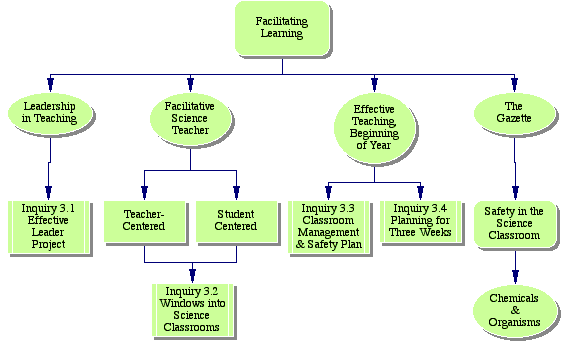
SECTION 1: FACILITATING LEARNING IN THE SCIENCE CLASSROOM
This chapter focuses on the role of the teacher in facilitating learning in the science classroom Four aspects of facilitation and management are presented in the chapter, and they can be presenteed in any order. These aspects include the facilitative role of the teacher, getting off to a good start at the beginning of the year, managing science materials and facilities, and safety in the science classroom. One of the key ideas of this chapter is the concept of leadership in the social process of the classroom. Several inquiry activities have been designed to aid in the development of leadership abilities including: The Effective Leader Project---observing and interviewing teachers and colleagues; establishing a classroom management plan; Windows into Science Classroms; The Three-Week Planning Project---developing classroom activities for an extended period of time; preparing an equipment order.
Initial Case to Consider: A New Student In Class
We've encouraged and supported hands-on and experiential science teaching as the driving force in establishing an innovative and inquiry-oriented approach to teaching. In this case to consider, your students are confronted with a story about a new student who arrives in class and seems to have some problems with participation and creates tension among the other students. We use this case to consider issues around the concepts of teacher-directed vs. student-centered teaching and learning.
Leadership in the Science Classroom
We have found that Harry and Rosemary Wong's work in their book The First Days of School is a powerful resource for prospective science teachers. I recommend using it a course leading up to an internship or student teaching, as well as a resource while the students are at school. We've used some of their work in this section, and designed an inquiry project that I've found to be very successful during a student internship.
Table 3.1 summarizes the Wongs' approach to classroom leadership, and I have used this framework to design Inquiry Activity 3.1. In the inquiry, your students will conduct an inquiry into one attribute of leadership, and report findings to peers.
Inquiry Activity 3.1: The Effective Leader Project
This inquiry is best accomplished when your students are participating in an internship or at least are involved with a a teacher or team of teachers in a practicum-type experience. This would also be a powerful activity in a graduate level course.
The project can be one of several activities that student's might accomplish in an internhip/pedagogical course. Take a look at a syllabus of a science pedagogy course where the Effective Leader Project was used as a "Middle School Classroom Management Project. This is a powerful project. Here is how the assignment was written up for the students:
This is a team project done with your Intern Partner. During your internship, you will be paired with another TEEMS student in a middle school classroom working with a mentor teacher. Using Harry Wong's book The First Days of School as a guide try and answer any one of the following questions that are related to the characteristics of effective teaching: (1) How are positive expectations communicated and demonstrated in your mentor's classroom?--see pp. 33 - 78 of Wong's book (2) What is the evidence that effective techniques are utilized to create a well managed classroom?---see the chart on page 87 and pp. 79 -194 of Wong's book. (3) What strategies does the teacher use to to design lessons that help student achieve success in science?--see pp. 195 - 268 of Wong's book. You should plan your project together, and then over the course of the Intern period "collect data" such as an interview with the teacher, digital pictures, sketches, samples of work to help answer your project question. Prepare a report in the form of a PowerPoint slide show, a web page, or a 3-panel poster report. Your presentations will be on November 21 on campus.
The Facilitative Science Teacher
There are three topics discussed in this section that focuses on the teacher's role as facilitative, and leadership-oriented. The topics included:
- Teacher-Centered Facilitation: The Traditional Perspective
- Effective Management Behaviors
- Facilitating Laboratory and Small-Group Work
- Student-Centerred Facilitation: A Humanistic Perspective
- Social Constructivism
- Cooperative Learning
- Facilitating High-Level Thinking Tasks
Inquiry Activity 3.2: Windows into Science Classrooms
This inquiry is a powerful experience in which your students will observe science instruction and classroom events by using videos produced by Annenberg Media (http://www.learner.org/). We designed a chart (Table 3.3) which your students can use to identify essential elements of classroom inquiry. There are two video sets: Case Studies or Teaching High School Science.
Effective Teaching for the Beginning of the Year
This section is important not only for the beginning of teacher's year, but for any internship or student teaching experience. Four aspects, especially important, in getting teachers off to a good start at the beginning of each new semester or course include:
- Room Arrangements
- Consideration of Rules and Procedures
- Rules for the Science Classroom
- Beginning and End of Class
- Handling Materials and Equipment
Inquiry 3.3, that follows, can be used to help focus your students on these important "beginning of the year" ideas.
Inquiry Activity 3.3: Developing a Classroom Management and Lab Safety Plan
We recommend that you have students work in small teams to design a classroom management plan that they would use given particular situations, eg. middle vs high school; physical science vs. life science.
The First Day (Lessons)
We've provided two first day lesson plans that you might use as "templates" for students in your course to evaluate in terms of their potential effectiveness. How would your students modify these plans, given different environements and situations?
First Lessons
You can use these three lessons to contrast different approaches (teacher-centered, and student-centered), and also ask, okey, now what do we do, and look at the section "beyond day one."
- Teacher-Centered: Physical Science
- Student-Centered: Earth Science in the Community
- Beyond Day One---focus on the planning chart that outlines the key actiivities for two weeks of work in a chemistry class
Inquiry Activity 3.4: Planning for Three Weeks
We've found this to be a powerful activity in the context of student teaching, or an internship program. Your students should work with their mentor, and develop a three-week plan (see the Three Week Planning Template). The plan should include the main topic for each lesson, and how the students will be involved with the topic. When the plan is completed, students should then code how they are involving students using the categories suggested in Inquiry 3.4, procedure #3.
Managing Classroom Materials and Facilities
Managing the classroom involves issues such as what materials are available for teaching, safety in the classroom, and the use of live organisms in teaching. You will find discussion of these key topics, as well as two important inquiry activities.
- Materials for Science Teaching
- Facilities for Science Teaching
SECTION 2: SCIENCE TEACHER GAZETTE
Safety in the Science Classroom
Chemical Safety
Living Organisms in the Classroom
Problems and Extensions
You will find a collection of questions that you can use for classroom discussion, as well as web-based bulletin board activities.
Readings
Some of the key literature on classroom management, safety, and perhaps one of the most important resources (The First Days of School by Harry and Rosemary Wong).
On the Web
We've included some key sites on science safety that should be helpful to your students.
Other Stuff- On the Companion Site
- Science Teachers Talk: How do you handle classroom managemnt? What advice do you have for a beginning teacher?
- Case Studies: The Ecosystem Study; The Smith's Come to School
- Links to Web
Chapter 4
Syllabus Helper
The focus of this chapter is on the goals and the development of ideas of the science curriculum. In the chapter we explore the changes in the goals of science education during the past century, but will pay particular attention to the contemporary nature of the science curriculum and reports and recommendations issued by a number of groups, commissions, and professional societies.
| Pedagogical Tool | Highlights/Content | Notes |
|
Initial Case to Conider |
Fallacies as Norms |
This case raises the issue that questions the nature of science teaching being used around the world. |
|
Invitations to Inquiry |
Focus questions for the chapter. |
Key invitations include How and why have the goals of science education changed, and what will science education emphasize in the early part of the twenty-first century? |
|
Inquiry Activities |
Inquiry Activity 4.1: The Goals of the Science Curriculum Inquiry Activity 4.2: Icons of Science Education: How Do They Tell the Story of Science Education Inquiry Activity 4.3: How Were Course Improvement Projects of the 1960s Different from the Reform Projects of the 1990s? |
Ranking goals of science teaching and comparing the results to a research study. An inquiry into the major phases of the history of ideas in science education by identifying icons. Comparing and contrasting projects from the Golden Age of Science Education to the Reform Era of the 1990s and into the 21st Century |
|
Case Studies on the Companion Site |
Devine Intervention New Science Goals---Just Another Fad |
The issue of creation science is explored. A parent objects to a "new" set of goals for a science course. |
|
Problems and Extensions |
Sample: Design a time line of events in the history of science teaching in the last two centuries. Plot the events on adding machine tape. |
A powerful way to help your students understand changes in their profession. |
|
Readings |
Included are some important books (the Pathway series) published by NSTA that help teachers understand the NSES. |
|
|
On the Web |
Links to key projects related to the development of the NSES. |
Agenda Strategies
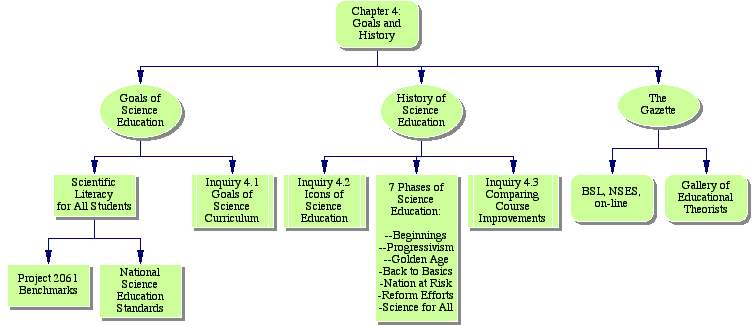
SECTION 1: GOALS AND PHILOSOPHY OF SCIENCE
This chapter provides an historical perspective on science teaching, and provides detailed information on the major reform efforts influencing science education, especially the National Science Education Standards, and Project 2061 of the American Association for the Advancement of Science.
You can use Inquiry Activity 3.1 as an introductory activity to help you find out about your students' understanding and opinions of science teaching goals. Inquiry Activity 3.2 (Icons of science education) can be the major activity for the chapter and will enable each student to become an expert on one of several phases in the history of science education. Inquiry 3.3 can be used to illustrate the similarities and differences in contemporary science programs from those developed in the past.
Case to Consider: Fallacies as Norms
Based on a speech by Jonathan Osborne of Kings College, England in which he identifies a number of norms that drive contemporary science education, which turn out to be fallacies.
Inquiry Activity 3.1: The Goals of the Science Curriculum
What do your students think science should emphasize? What do they think should be the goals of science? That's what this inquiry is about.
We recommend you divide your class into three groups, and name them the elementary, middle and high school groups. Give each a set of goal cards (from the Inquiry Activity). Make one copy of the cards for each team, and have them cut them up to form a deck of 11 cards, each with a different goal.
Follow the procedures outlined in the inquiry. Have each team report their results to the whole class. What were the differences among the teams, e.g. elementary, middle and high school? Compare these results with the results that Weiss found.
Science Education Reports
We've reviewed two reports in this section of the chapter:
**Essential reports for your students---viewable online using the links above. I also recommend that you add to this list your own state education website with a link to the science curriculum standards.
These two reports have had tremendous impact on the science education community. Its impact has had a wide range of effect, not only for the classroom teacher, but for science educators and scientists developing proposals for funding from state and national agencies.
We recommend that your students become familiar with the Benchmarks document of Project 2061 and the National Science Education Standards. Both of these reports are used in subsequent chapters, especially with respect to the science curriculum, and the develop of teaching strategies and lesson plans.
You might use the Jigsaw strategy in your class while investigating the above reports. Assign a report to a different group in the class so that they become the "experts" on that report. Tell them that their assignment is to create visuals (poster, Powerpoint, webpage), and present the results to the class. Indicate that their job is show how the report/project can be practical in the development of curriculum and lesson plans. Their reports should not take more than 10 minutes.
Influence of Research on the Goals of Science Teaching
The rationale and direction of the reports that are outlined in the previous section are based (at least to some degree) on the work of researchers in the field of science education. Thus, this section in the chapter highlights that fact, as well as points out that in the Science Teacher Gazette of each chapter there is a column called Research Matters which are consumer-like research reports from a resource of the National Association for Research in Science Teaching called Peers Matter. The Peers Matters link is still not active, but you can access the earlier NARST Research Matters site.
History of Science Education
Preliminary Icons Activity: An activity we like to do with our classes (especially advanced graduate level courses) is a simplified version of the Icons of Science Education inquiry. In this simplified version, you will need 5 index cards (or Post-it notes) for each student; colored marking pens; a blank mural (tape together 4 or 5 large sheets of chart paper and tape to a wall in your classroom), masking tape. Draw three lines accross the width of the mural and label the lines science, technology and science education, respecitively. Ask your class for a few of examples (two or three) of icons---powerful discoveries, persons, instruments---that have influenced science, or technology, or science educatioin, e.g. invention of the telescope [1608], discovery of the structure of DNA [1953], Scopes Trial [1925]. The students may not know the exact date, but encourage them to give a + or - 10-15 years. After they get the idea, have them work individually to generate at least five icons. Have them consider the fields of science, technology and science education. If your classes are like mine, the science and technology categories will exceed what your students know about science education. When they have completed their list have them post their icons on the mural.
| Science |
| Technology |
| Science Education |
You should follow up with a discussion of the results. How does one field infuence the other? Are there relationships among the three that the students can identify?
Inquiry 3.2: Icons of Science Education: How Do They Tell the Story of Science Education?
We have divided the history of the development of ideas in science education into seven phases. If you can, divide your class into seven groups, assigning one phase to each group. Each team is to assemble icons from their assigned period. These can be exhibited on poster board or 3-panel posters, or if you build a class mural timeline, then each team can post their results there in the appropriate time frame on the timeline.
Phases include: (These can be the groups in your class)
I: The Roots of Modern Science Education, Pre-1900-1930
II: Progressive Education and Science, 1930-1950
III: The Golden Age of Science Educatioin, 1950-1977
IV: Textbook Controversies and Back to Basics, 1977-1983
V: A Nation At Risk, the 1980s
VI: The Reform Efforts of the 1990s: A Contrast with the Golden Age
VII: Science for All and the New Millennium
Students should use the inquiry questions to help them research their phase and find icons. The questions are the same for each phase.
Inquiry Activity 3.3: How Were Course Improvement Projects of the 1960s Different from the Reform Projects of the 1990s?
In this inquiry, your students can learn about and compare projects developed in the 1990s and are in use today, to the reform projects of The Golden Age in science education. The reform projects of the 1990s all have websites, so you can use them for the students to do their investigations. Select one project from the Golden Age, e.g. BSCS Biology and a reform project from the 1990s, e.g GLOBE and use the criteria in the text's Table to discuss the differences. You can use the questions in ghd procedures section on page 102 to guide your discussion.�
SECTION 2: SCIENCE TEACHER GAZETTE
Think Pieces
Students are encouraged to think about how new developments in science education impact education.
Cases to Consider (on the Companion Site)
- Case Study: Rehashing theSixties
- In this case, Newsome Wave (a fictional character) challenges the AAAS Report (Science for All Americans) as being elitist, and seemingly remote from the business of real schools (a return to the 60s approach to science eduction, according to Wave). Rginald regis, coordinator of a western school district is an advocate of the report and wrote a blistering rebuttal to Wave's assertions. Students are asked to look at each side of this debate, and make their own positions known.
- Case Study: New ScienceGoals---Just Another Fad
- New approaches in education are sometimes viewed as fads by the general public. This case encourages students to look at the Project Synthesis proposals which include goals including personal needs, societal issues, academic knowledge and career education. STS in tone, this approach makes one parent "sick and tired" of these "new education fads."
Problems and Extensions
Three problems are outlined that engage students in exploring the goals and development of science education.
Readings
The readings will direct your students to practical resources related to the goals of science education, and the science standards.
On the Web
A collection of resources that link to key projects in the history of science education.
Chapter 5
Syllabus Helper
The focus of this chapter is on the exploration of the science curriculum, 5-12. In addition to exploring the standards that have been developed to guide curriculum, you will find separate sections of middle school science, and high school science. And a special feature of the chapter is the science curriculum: a global perspective. In this section, reports written by educators from Australia, Chile, China, Ghana, Japan, Russia, and Turkey give us a global reach as we consider the issues of science curriculum.
| Pedagogical Tool | Highlights/Content | Notes |
|
Initial Case to Consider |
Curriculum Map Conundrum |
Should the science curriculum be organized around thematic units? |
|
Invitations to Inquiry |
Key focus questions for the chapter |
Key invitations including What are the characteristics of exemplary elementary, middle and high school science programs? |
|
Inquiry Activities |
Inquiry Activity 5.1: Science Curriculum Patterns, p. 130 Inquiry Activity 5.2: Exploring Science Curriculum Materials, p.136 |
Students compare curriculum patterns using school district curriculum guides. Using evaluation critieria, students analyze two science textbook programs |
|
Special Feature |
Science Curriculum in Other Countries |
Written by science educators from these countries: Australia, Chile, China, Ghana, Japan, Russia, and Turkey |
|
Cases to Consider (on the companion Website) |
Unified Science The Science Proficiency Race |
Is an integrated or unified science program a justifiable change? Very few schools have done this? Is it a viable curriculum model? Is comparing international test results across nations valid? It's done all the time; should it? |
|
Research Matters |
Using Textbooks for Meaningful Learning in Science by Sarah L. Ulerick |
Referencing constructivism, the author provides alternative ways to use and learn from science textbooks. |
|
Problems and Extensions |
Sample: Visit a high school science teacher and interview the teacher about his or her science course. What program or textbook does the teacher use? How effective is the course with the teacher's students? |
A collection of problems and extensions about the science curriculum. |
|
Readings |
Important articles and books on the science curriculum. |
|
|
On the Web |
Links to key websites connected to curriculum development. |
Agenda Strategies
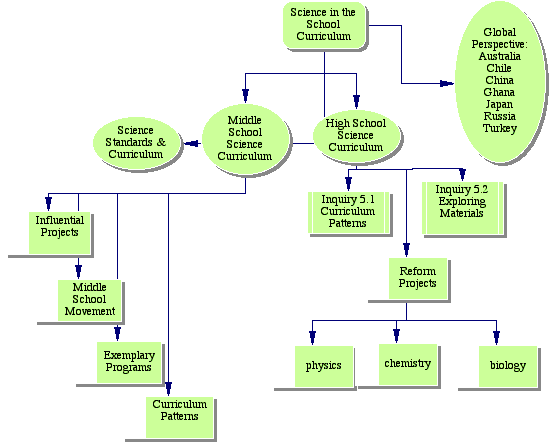
SECTION 1: THE SCIENCE CURRICULUM
This chapter presents and explores the science curriculum, 5-12. We've divided the chapter into sections on the science standards and curriculum, as well as separate sections on middle and high school science, and finally a section on science curriculum in Australia, Chile, China, Ghana, Japan, Russia, and Turkey.
This chapter can be used as an inquiry into science teaching at the middle and high school levels. Even if you are working with students who are high school students, there is a great deal of validity in having them explore science teaching at the middle and high school levels, and we could say the same of prospective and professional middle school science teachers.
Case to Consider: Curriculum Map Corundrum
Teachers in a science department debate the State Department of Education's plan to organized the 8th grade science curriculum into five thematic units. Opposition appears within the faculty.
The Science Standards and the School Science Curriclum
Here you will find a brief overview of the National Science Education Standards which were introduced in the last chapter. You might want to demonstrate going to the Standards Online to show your students:
- Goals Underlying the Standards
- Unifying Concepts and Processes Standards
- Science As Inquiry Standards
- Physical, Life, and Earth Space Science Standards
- Science and Technology
- Science in Personal and Social Perspectives
- History and Nature of Science
You will find a discussion of the Standards as they relate to elementary, middle and high school science in the sections that follows.
Inquiry Activities
There are two inquiry activities that you can use to organize the content of the chapter. In the first inquiry students do an investigation of state and local school district curriculum patterns; in the second inquiry, students examine two or more science textbooks and evaluate them against a set of criteria.
Inquiry Activity 5.1: Science Curriculum Patterns
In this inquiry students are asked to compare two different school district or country curriculum patterns. If you are working with pre-service teachers, you might select districts that you are using in the field-based component of your program. Graduate students might be interested in comparing countries. You can obtain the districts' curriculum guides from the curriculum department, or online at the districts website. Here for example is one districts framework online. If you are working with a graduate level or in-service group of science teachers, have them bring to class their curriculum guides for this inquiry.
You can follow the procedures outlined in the inquiry, or you might want to have your students compare one district's science curriculum to the state standards, or to the national standards.
Inquiry Activity 5.2: Exploring Science Curriculum Materials
The charts on this page list the influential and exemplary science projects for elementary, middle and high school. Use these projects as the data base for designing this inquiry activity. Be selective, and try and make the activity relevant to your students' prior and new experiences.
If you use a team approach, you might assign one team the task of looking at elementary science texts, another middle school science, and the third team high school science.
Science Curriculum: A Global Perspective
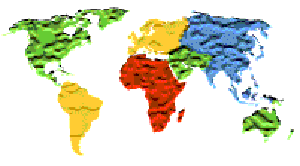
The science education community extends beyond the boarders of any country and is an active force throughout the world. We live on a planet that some describe as a global community. Computers, satellites, FAX machines, telephones and television bring educators together from countries as far apart as Australia and the Russia. What is the education of students in other countries about? When do students begin studying science in other nations? What is the nature of the science curriculum in other countries?
We asked colleagues from other countries to write brief descriptions describing the curriculum and teaching issues in Australia, Chile, China, Ghana, Japan,Russia, and Turkey. As science educators, we are members of a community of practice that is worldwide. What the issues in other countries, and how do these help inform us about our own issues? The authors of these international pieces have based their writing on personal experiences with the culture. In most cases the authors were born, educated and taught in the country they described.
This section can be a reading experience followed by a discussion of similarities and differences in science curriculum among these countries. You might assign a team to each country, and then ask each team to prepare a short report and a visual of some kind which will be used in a conference on science education in other countries.
This section is also an opportunity to ask students in your class who were born and educated in an other country to share their experiences, and ask them to identify differences in their experiences.
You will find some links to websites that will provide additional information.
Australia by Roger Cross. See the Government Education Portal of Australia. Chile by Claudia Rose. See the Ministery of Education of Chile site. China by Ronald Price. See the China Online Ministry of Education of China. |
Ghana by Charles Hutchison. See the Official Ghana Education Home Page. Japan by Shigehiko Tsukahara. See the Ministry of Education, Culture, Sports, Science and Technology. Russia by Sergei Tolstikov. See the Ministry of Education of the Russian Federation. Turkey by Fatih Tasasr. See the Ministry of Education for further information. |

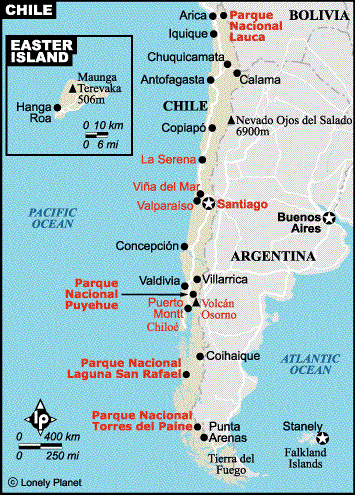
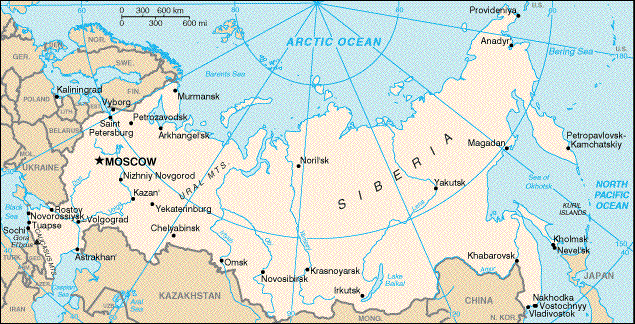
The Middle School Science Curriculum
In each of the sections on middle and high school science curriculum, some results on the character of teaching from a study by I. R. Weiss (Report of the 2000 National Survey of Science and Mathematics Education) are followed by focus on influential or reform projects, standards for that level, and exemplary projects. The figure below shows these foci.
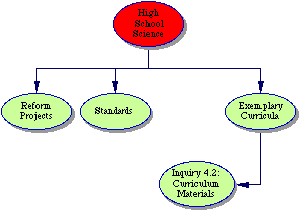
Standards for middle school science focus on science as inquiry. Projects that influenced middle school science highlighted inquiry. Contemporary middle science projects put emphasis not only on inquiry but on the application of science.
Influential Middle School Projects |
Exemplary Middle Science Projects |
Introductory Physical Science (IPS) Earth Science Curriculum Project (ESCP) Intermediate Science Curriculum Study (ISCS) |
Middle School Science and Technology Geology Is Investigating Earth Systems Sci-Math Informal Science Study (ISS) |
The High School Science Curriculum
You might have your students compare high school curriculum patterns with the middle school patterns. Each table is based on data gathered by Weiss in the year 2000 study of K-12 school science and mathematics (link to the status of middle school science and high school science--links to high school earth science, biology, chemistry and physics). What do students predict students do in middle school vs. high school? Why do they think this? What are their ideas after seeing the Weiss data?
Influential High School Projects |
Exemplary High School Science Projects |
PSSC Physics Project Physics CHEM Study BSCS Biology |
Biology: A Community of Practice Insights in Biology Active Chemistry Active Physics Conceptual Physics |
SECTION 2: THE SCIENCE TEACHER GAZETTE
Case Study: Unified Science (on the companion site)
In this case, should the science curriculum move toward the pole of a unified science approach. This is a good case to discuss the ongoing notion of "curriculum change."
Case Study: The Science Proficiency Race (on the companion site)
In this case a professor presents data from a recent international study showing US students lagging behind their counterparts in many other countries. Are these results valid for cross-national comparisons?
Research Matters: Using Textbooks for Meaningful Learning in Science by Sarah L. Ulerick (Full text on the Companion site).
Textbooks are the mainstay of the science curriculum. This article is powerful in that it looks at how science texts can be used in ways that contribute to meaningful learning. You might have student brainstorm how they think texts could be used to motivate students and make learning meaningful. Then have them read the Ulerick article, followed by a discussion comparing their initial suggestions and the ideas in the article.
Problems and Extensions
The P & E contain good examples of follow up exercises that will extend students' understanding of the science curriculum. For example, P & E #1 asks students to make recommendations describing goals and currciulum for a middle school.
Readings
You will find a number of resources on curriculum on page 162. One you might look at is Paul DeHart's "Transfroming Middle School Science Education," a powerful statement on revamping the middle school science curriculum.
On the Web
Search the links for chapter 4 related to the science curriculum. One in particular that is quite useful is the Education Development Center's curriculum library.
Other Stuff- On the Companion Website
- Chapter Powerpoint Presentation
- Science Teachers Talk: How do you decide what content to teach and how much time to devote to each area? What are the strenghts and weaknesses of the science curriculum you currently follow?
- Cases to Consider: Unified Science; Science Proficiency Race.
- Links to Websites
Chapter 6
Syllabus Helper
STS represents a departure from "traditional" science education, as it tends to see curriculum in an interdisciplinary context and in the context of personal and social perspectives. As you work with this chapter, reflect on your views of science as they relate to your science discipline, and ask yourself how these disciplines interact with technology and society. There are many interesting strategies of teaching presented in this chapter, and you might want to focus on them. Also, you find a couple of case studies of curriculum projects that are based on STS. You might also have your students visit the websites of these two projects (and others).
| Pedagogical Tool | Highlights/Content | Notes |
|
Initial Case to Consider |
A Student-Centered Project |
As part of a teacher's biology course, students propose a human reproduction project, but run into a conflict with the school principal. |
|
Invitations to Inquiry |
Focus questions for the chapter |
Key questions that focus students on S-T-S issues and teaching science. |
|
Inquiry Activities |
Inquiry Activity 6.l: Getting Involved in STS Inquiry Activity 6.2: STS Issues in Science Textbooks Inquiry Activity 6.3: STS Module Design Inquiry Activity 6.4: Evaluating an STS Module or Project |
Students participate in an STS project. Using an STS rubric, students analyze science textbooks. Students sketch the elements of an STS module. Using STS critieria, students evaluate an STS module. |
|
STS Strategies |
Strategies
|
These strategies can be used with any type of STS content, and are designed to engage the students in explorations and activities. |
|
STS Themes & How to Teach Them Note: You will find the Air Quality theme in the Gazette; the other themes can be accessed on the Companion Site |
Themes include:
|
Each theme contains content information as well as suggestions for actions that could be taken. The actions are suggestions for teaching strategies that students might use in developing an STS unit or module. |
|
Science Teachers Talk (On the Companion Website |
Teacher's discuss: How do you deal with STS issues in the classroom? |
Read what teacher's do, and compare it to your own approach. |
|
Cases to Consider (on the Companion Website) |
STS as the Entire Science Program: Some Questions Biased Teaching? |
A teacher ojects to STS as a full-fledged program. A parent object's to a teacher's reading list claiming it is biased. |
|
Science Education Literature |
Education for Environmental Sustainability by David L. Haury |
A key article on sustainability and how science teacher's might deal with the topic. |
|
Problems and Extensions |
Sample P and E: What research skills will students need to develop in order to carry out STS action projects? |
Several problems to engage students in STS issues and questions. |
|
Readings |
Key readings on STS |
|
|
On the Web |
A collection of STS websites |
Agenda Strategies
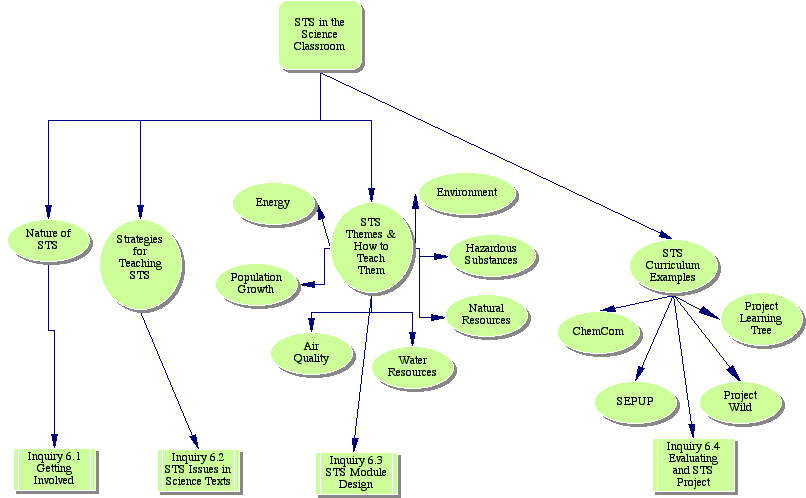
SECTION 1: STS IN THE SCIENCE CLASSROOM
STS represents a departure from "traditional" science education, as it tends to see curriculum in an interdisciplinary context and in the context of personal and social perspectives. As you work with this chapter, reflect on your views of science as they relate to your science discipline, and ask yourself how these disciplines interact with technology and society. There are many interesting strategies of teaching presented in this chapter, and you might want to focus on them. Also, you find a couple of case studies of curriculum projects that are based on STS. You might also have your students visit the websites of these two projects (and others).
Initial Case to Consider: A Student-Centered Project
Initial Case to Consider: A Student-Centered Project
Is a project involving students in investigating human reproduction within the guidelines of science education? Students propose such a project, but the principal of the school demands a discussion. What evidence can the teacher bring to support reasons for such a project?
The Nature of STS
This chapter represents content that we have favored for many years, and find very exciting to introduce to not only prospective teachers, but teachers in-the-field.
In the first section, a brief review of the historical roots of STS is presented, and you might have students read this section and ask how their intial view of STS compares to the views expressed here.
STS Understandings referenced in the National Science Education Standards are shown below. These are familiar themes that appear in texts, and the focus on teacher-designed units of teaching. They are good starting points for work in the STS area.
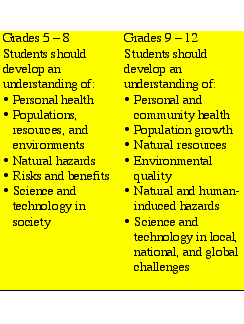
Figure 6.1: STS Understandings in the National Science Education Standards
Characteristics of STS
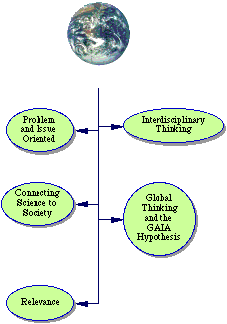
Figure 6.2: STS Concepts
You might use the graphic above as a vehicle to discuss the key characteristics of STS.
- Problem and Issue Oriented
- Interdisciplinary Thinking
- Connecting Science to Society
- Global Thinking and the GAIA Hypothesis
- Relevance
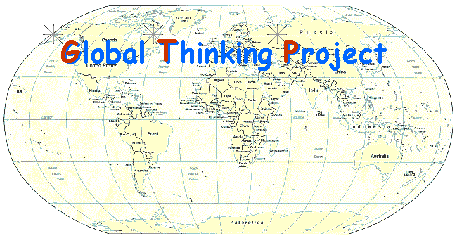
Figure 6.3: The Global Thinking Project used the concepts of STS to create an Internet-based program that involved students in investigating local environmental issues and problems.
Inquiry 6.1: Getting Involved in STS
This inquiry contains suggestions for getting your class involved in an STS project. I have found that projects like the ones suggestions are powerful ways to make STS practical.
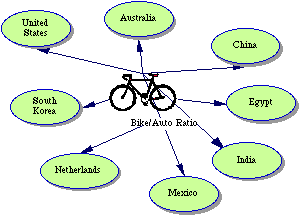
Figure 6.4. An STS Project: Which of these countries has the highest bicycle-to-auto ratio? Which the lowest? You can check your results on p.407.
Strategies for Teaching STS in the Classroom
This section includes five different strategies that I hope you will find useful in helping your students design STS lesson plans and units of study. The strategies are underscored by helping students take responsibility for clarifying their values on moral and ethical implications of science.
- STS Value Dilemma Sheet--This strategy uses a provocative statement or illustration to engage students in a discussion of "dilemma questions."
- STS Action Drama--Roleplaying is the focus of this strategy. Students can make use of newspaper stories, congressional decisions and new laws as the basis for the content of action dramas.
- Case Studies--Cases allow students to apply debate strategies to solve a case. Cases are quite powerful, and can involve students in discussions of real issues. For a powerful site on cases, take a look at the National Center for Case Study Teaching in Science.
- Online Dilemma Discussions--With the use of an online bulletin board, you can involve your students in a number of discussions of issues in science. I've shown some responses of high school students as they participate in an online discussion of cloning.
- Think Pieces--Designed to stimulate reflection on important questions, Think Pieces are a powerful strategy for your students to use in their teaching lessons and units of instruction.
Inquiry Activity 6.2: STS Issues in Science Textbooks
In this inquiry, students analyze science textbooks using a classification of STS issues. The categories include key STS issues, such as human behavior, population growth, food supply, human reproduction, etc.
The STS Module
We have found that encouraging students to design an STS module, or mini-unit a powerful way to encourage the application of the strategies and themes outlined in this chapter.
You might introduce your students to Wiesenmayer and Rubba's environmental model. They outline a four stage process or instructional sequence as identified here:
- STS Foundations
- STS Issue Awareness
- Issues Investigation
- Action Skill Development
Inquiry Activity 6.3: STS Module Design
Using the four stage STS design mentioned above, in this inquiry students will apply the concepts introduced in this chapter. You could use this as the major activity of the chapter, and have students work in teams to develop a module, and present to the class for feedback and review.
STS Themes and How to Teach Them
This section presents eight STS areas as potential themes for an STS unit or course of study. Naturally, there are other theme areas. A brief discussion of the theme is followed by suggestions for actions (classroom activities) that your students might use with K-12 students. I typically develop a project around one of these themes, and have students become involved in real STS project at the university or seminar level, and then have them apply what they did with students in the K-12 environment.
For example, in the figure below, a group of prospective science teachers worked in a team to investigate the effects of ozone on human health. After doing research on monitoring ozone locally (they used the Ecobadge System), and finding literature and websites to support them, they developed a poster that represented the STS work they did on ozone. In this case, a highway sign advertising effects of ozone.
�
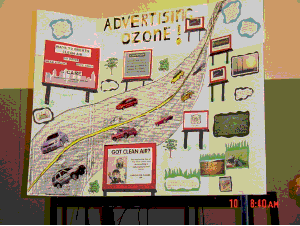
Figure 6.5. This poster was one of about 6 posters developed as part of an STS project on a university campus. Working in groups, students set up a display in the lobby of the College of Education building that informed the GSU community about ground level ozone, the problems associated with increasing levels of smog, and what they can do about the problem. This was designed to help them make connections to their upcoming fall internship at two middle schools.
- Population Growth
- Air Quality and Atmosphere--There are many projects that have air quality activities such as GLOBE or Eco-connections.
- Energy
- Effects of Technological Development
- Hazardous Substances
- Water Resources--Shown below is a dissolved oxygen ampule kit that can be used to determine the dissolved oxygen level of streams and lakes. For a sample unit based on water resources, link to the Eco-Connections module "Testing the Waters."
Figure 6.6. These are tools that are part of Chemetrics visual test kits that used ampules to carry out a variety of water analysis tests. In this case, you see the dissolved oxygen test kit. We've used these for many years, and find them inexpensive and fairly accurate, especially when students are involved in collaborative projects with students at distant locations around the earth.
- Utilization of Natural Resources
- Environment
STS Curriculum Examples
There is a wide range of curriculum examples available to study and implementation. Many of these projects have websites, and students can gain further knowledge about them.
- STS Evaluation Critieria Before you have your students examine STS curriculum examples, you might want to introduce STS evaluation criteria (p.426).
- Curriculum examples:
- Curriculum example: Science Education for Public Understanding (SEPUP). A middle school project designed to engage students in a study of environmental issues and content.
- Curriculum example: ChemCom (Chemistry in the Community). ChemCom enhances science literacy by emphasizing chemistry�s impact on society. It is aimed at the student who will become a citizen but not necessarily a scientist in a technological society.
- Curriculum example: Project Learning Tree (PLT). A K-12 environmental education program.
- Curriculum example: Eco-Connections. A collaborative project between American and Russian educators centered around environmental and global issues.
Inquiry Activity 6.4: Evaluating an STS Module or Project
You can use this inquiry activity as vehicle to have students evaluate one or more of the curriculum examples cited above. Criteria are outlined in the inquiry.
SECTION 2: SCIENCE TEACHER GAZETTE
Case to Consider: STS as the Entire Science Program: Some Questions (on the Companion Webiste)
A teacher questions the STS approach on the basis of knowledge base that students might have to discuss STS issues, and of having science teachers deal with values. A powerful case for class discussion.
Case to Consider: Biased Teaching? (on the Companion Website)
A parent claims that the articles that a teacher is having students read is highly biased, and feels that the teacher is indoctrinating the students with "environmental sentimentality." What should teachers do in situations like this one?
Science Teachers Talk: How do you deal with STS issues in the classroom? (on the Companion Website)
Ask your students to discuss how they would implement STS in the classroom, and then have them read the discussion among four teachers.
Science-Teaching Literature: Education for Environmental Sustainability by David L. Haury
Haury identifies key concepts, and issues a challenge to schools and communities. You might check these websites in conjuction with this paper.
- Second Nature: Education for Sustainability
- President's Council on Sustainable Development
- Envirolink: The Online Environmental Community
Problems and Extensions
You will find among the P and E's good examples of projects for students to complete individually or as part of a team.
Readings
You will find a variety of readings on STS; We particularly recommend Cross and Fensham: Science and the Citizen. Melbourne: Arena Publications, 2000.
On the Web
The Web will be a major resource to access STS issues, projects, and programs. We've included a number of these sites to get your students started.
Chapter 7
Syllabus Helper
This chapter is correlated with Chapter 7, in which ideas of several theorists explaining how students learn were presented. This chapter presents models of teaching based on those theories of learning. The models presented here are the scaffolding that will be helpful to your students as they begin to plan lessons and create an environment in the classroom that fosters active student involvement. Underlying all of the models presented is the notion that students should be involved.You can start anywhere in the chapter. Each model has its own protocols, and can be implemented using the material in the chapter.
| Pedagogical Tool | Highlights/Content | Notes |
|
Initial Case Study |
Descent from Innocence |
A teacher has a rude awakening when he attempts to implement a hands-on, inquiry-oriented lab. |
|
Invitations to Inquiry |
Focus questions for the chapter |
The focus questions reinforce the idea that this chapter is practical in nature, and that there are multiple models of teaching that can be implemented in science teaching. |
|
Inquiry Activities |
Inquiry Activity 8.1: Designing Project-Based Activities Inquiry Activity 8.2: Science Teaching as Inquiry |
Students design a science project based on the constructivist model of teaching Students read an article from the Science Teacher on inquiry, and then observe "inquiry" videos on the Annenberg Media site. |
|
The Models of Teaching |
Constructivist Model of Conceptual Change Sociocultural Models: The Role of Collaboration
Inquiry Teaching Direct-Interactive Teaching Model Other Models (on the Companion Website)
|
Each of the models listed to the left has its own protocols and examples. We've given specific details for each model in the chapter so that they can be implemented with peers and in the school environment. |
|
Lessons (on the Companion Website) |
Learning Cycle Lesson 1 Learning Cycle Lesson 2 |
What can be learned from skulls? What caused the water to rise? |
|
Science Education Literature (on the Companion site) |
Breaking into Inquiry by Charles Eich, et.al. |
An important piece of research on why teachers should consider inquiry teaching; details on how to go about doing inquiry in the classroom |
|
Science Teachedrs Talk (on the Companion Website |
Teachers discuss: What are some of the best ways tdo get your students thinking in your science class? Is the discovery or inquiry model of teaching important in your approach to teaching? Why? |
Hear from many teachers on these two questions. |
|
Problems and Extensions |
Sample problem and extension: One criticism of inquiry and disovery methods of science teaching is that this approach takes too much time, and students can learn concepts and skills is presented more directly. Debate this criticism by first taking the side of inquiry and then the side of direct teaching. In which were you more convincing? Is there a solution to this problem? |
This and the other P & E's can be used to involve your students in applying in practical situations the major concepts in the chapter. |
|
Readings |
There are many good articles and books on models of teaching. You might introduce your students to the Joyce and Weil book entitled "Models of Teaching." |
|
|
On the Web |
You'll find several practical teaching websites. |
Agenda Strategies
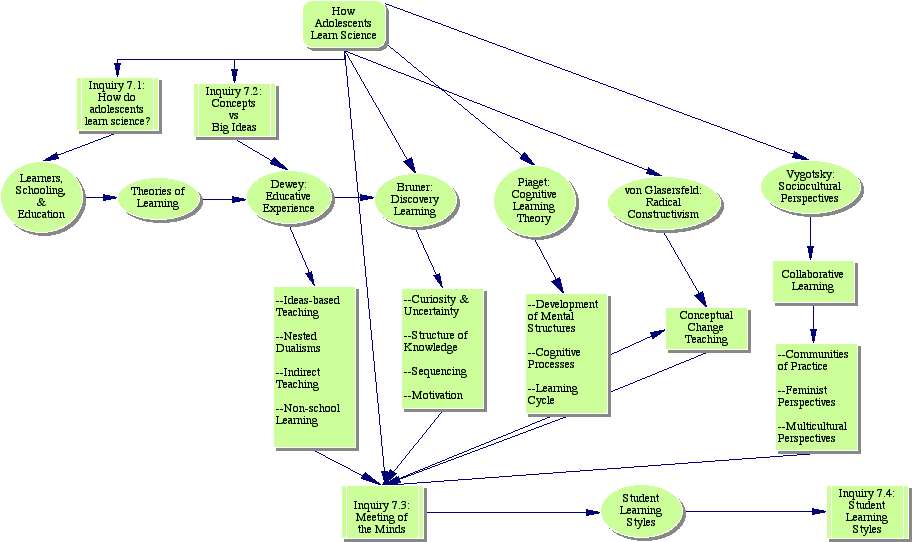
SECTION 1: HOW ADOLESCENTS LEARN
This chapter organizes ideas about learning into two key topics, theories of learning and learning styles. You will also find that Chapter 8, Models of Science Teaching, is correlated with the theories that are presented here. Although Chapter 7 is more theory-oriented, and Chapter 8 is more practical, together they form an important link between theory and practice.
Initial Case to Consider: A New Approach to Learning
A second year teacher implements a constructivist approach to teaching in her high school biology class. A parent complains to the teacher's principal claiming that her son is wasting his time in this class. You can use this to start the chapter in class. An alternative way is to set this case study up on your bulletin board, and request that each student make at least one post to the case prior to coming to the next class. At the next class session, divide your students into five groups, and assign each group one of the questions that appears in the text related to this case. Questions include: How would you deal with this situation? What would you say to the parent? Is the teacher on sound footing regarding her theory of teaching. Give each group 5 - 10 minutes to discuss the question, and arrive at consensus, and be prepared to make a 2 minute report to the full class.
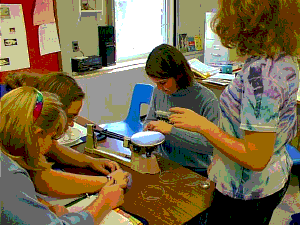
Figure 1. Team learning is an integral aspect of implementing a constructivist approach to teaching in the science classroom.
Inquiry Activities
There are four inquiry activities in this chapter. These can be used in a variety of ways to engage your students in the content of the chapter. You could do all of the inquiry activities with your class, or you could assign each inquiry to a different group in the class. Devote one class session enabling each team to work together to accomplish the tasks associated with the inquiry. Each team then will be responsible for "teaching" about their inquiry. Inform them that they will have no more than 15 minutes to convey the essential ideas to the class. Then integrate these inquiry reports into your plans for this chapter.
Inquiry Activity 7.1: How Do Students Learn Science?
In this inquiry student will assume the role of researcher and interview one or more teachers or peers seeking the circumstances in which they think students learn science best. Students will need to design a series of interview questions that appear in the text and then conduct the interviews.
With pre-service teachers: If possible arrange for your students to interview some practicing science teachers. Arrangements could be made for them to visit a middle school or high school, or if you are teaching a graduate science education class of practicing science teachers, make arrangements for your in-service teachers to interview them. If neither of these arrangements works, have them interview each other, or other pre-service students at your college.
With in-service & advanced graduate students: If your class is populated with practicing teachers, they can be "interview subjects" for each other in this activity, or they can interview one or more teachers at the school where they teach.
Depending upon how you want the results to be used, suggest to the students that use audio and video in their interviews (but make sure that they obtain permission for this, and how the results will be used). The audio and video results can be used as part of a presentation on "how students learn science."
This is an important process (interviewing), and you might want to carry this forward into your student's practicum and teaching experiences.
Inquiry Activity 7.2: Concepts versus Big Ideas: A Deweyan Experience
In this activity students will select a cluster of concepts that they might teach in one area of science (perhaps from the NSES or the Benchmarks, or the State Standards where you teach). The notion in this inquiry to help students identify and articulate "big ideas" that subsume the concepts that they select.
Inquiry Activity 7.3: Meeting of the Minds
In this roleplaying inquiry, students assume the roles of theorists, and generate a discussion of teaching and learning from the various frameworks represented by the theorists. This would be a good activity to video tape, and then play back for analysis and discussion.
Inquiry Activity 7.4: Ideas About Student Learning Styles
This activity is best done in small groups whereby students collaborate to generate concepts maps reflecting what they know about (1) Factors affecting student learning styles and (2) What are ways to accommodate students with different learning styles? If you split your class into teams, some teach can be charged with concept map 1, and others with concept map 2. Have them draw their maps on very large sheets of chart paper, and have them use these to share their completed map. Use this activity as an introduction to the section on Student Learning Styles.
Students and Science Learning
You might present the chart below. Instead of including the items below the headings, brainstorm with the students on the first two categories (learn about and learn how to). Have the students generate at least three ideas in each category.
They can learn about |
They can learn how to |
Processes they undergo |
Knowledge products of scientific inquiry Nature of the scientific enterprise |
Act upon or apply information Learn strategies to seek new knowledge |
Internalize values Assess self interest in science |
Theories of How Students Learn
This brief section is an introduction to the sections that follow on specific ideas of five theorists: John Dewey, Jerome Bruner, Jean Piaget, Ernst von Glasersfeld, and Lev Vygotsky.
A couple of points. Firstly, there are some science educators who would suggest delaying the introduction of theory by letting it evolve out of practice. This might be considered the "practice-to-theory" path. Alternatively, you might be more drawn to the "theory-to-practice" pathway. In either case, practice and theory are linked, and we might consider them going together like peanut and jelly! For us, you can't have one without the other. Thus, we recommend thinking of Chapter 7 (more theory oriented) and Chapter 8 (more practice oriented) as a bonded pair.
You might also point out to your students that the section in the Science Teacher Gazette entitled "Research Matters" is a wonderful example of linkages between practice and theory. These are consumer oriented research reports written by members of the National Association for Research in Science Teaching. They show the value of research to the practicing science teacher. You will find several of these reports on the Companion Website.
Organization of Theories of Learning
Table 7.2 in the text (Comparison of Theories and Perspectives of Learning) should help you organize the next three sections on learning theories. Five theorists' ideas are outlined in the Table, and then each is discussed in the sections that follow in the text. The complete chart is a useful teaching and learning tool for the chapter. You can use it as a graphical advanced organizer helping your students mentally organize the theories that will be introduced here, and tied to the very practical models of teaching in the next chapter.
Constructivist Theories of Learning
"Constructivism asserts that knowledge resides in individuals; that knowledge cannot be transferred intact from the head of teacher to the heads of students. The student tries to make sense of what is taught by trying to fit it with his/her experience." This quote is from the Research Matters piece in the Gazette of this chapter by Lorsbach and Tobin. According to these researchers, constructivism is an epistemology (branch of philosophy that studies knowledge), a theory of knowledge used to explain how we know what we know.
You might use the Figure below to do a deomonstration with your students (The coin toss and throw). In the figure, a coin is tossed into the air and comes down on a surface. After you do the demo, make a drawing similar to the one shown in the Figure 5.1 and then ask "What are the forces on the coin at point B, when it is moving upward through the air."
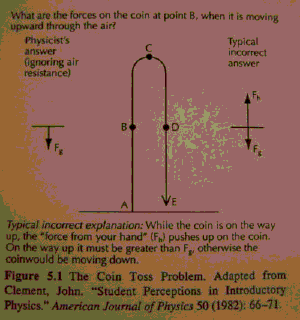
Figure 2. Coin Toss Problem
The results should demonstrate that many students (including yours) hold alternative (naive, misconceptions, incorrect) ideas, as will many, if not most of their students.
Sociocultural Theories of Learning
Three prespecitives are presented under this rubric, including sociocultural, feminist and Deweyan. In a sense this is amplication and extension of the previous section on constructivism. However, in this case, a greater emphasis is on learning in a social context. I strongly recommend that you read J. L. Lemke, "Articulating Communities: Sociocultural Perspectives on Science Education," Journal of Research in Science Teaching 38, no. 3 (2001): 296-316.
The sociocultural perspective implies that the construction of learning takes place in groups and by implication that collaborative (cooperative) learning strategies needs to implemented in science classrooms. You will find many applications of cooperative learning in The Art of Teaching Science. See Chapter 8 for details on implementing cooperative learning.
The feminist perspective aligns with sociocultural theory. Two concepts are important here. The first is the notion of situated cognition, and the second is the idea of a community of practice.
The Deweyan theory of experience is based on John Dewey's philosophy of education. Two ideas are presented here, the conception of learning, and experience and ideas-based teaching. Dewey believed that learning is embedded in experience, and thus you might want to look carefully at his "ideas-based teaching" conception. This is another way of looking at situated cognition, in that teaching consists of providing worthwhile experiences that lead to transformation.
Have your students particiapte in Inquiry Activity 7.2 (Concepts versus Big Ideas: A Deweyan Experience).
Student Learning Styles: Implications for Teaching
There three important concepts in this section and they are: (1) The psychology of learning styles and the learning styles model; (2) Brain-Based Learning and the 4 MAT System; and (3) Metacognitive Strategies
Present the Learning Styles model developed by Rita and Ken Dunn. Ask your students under what conditions they like to study and learn? Do they like it quiet? Do they study alone? You might want to visit the The Learning Syles Network. Another interesting site is the Institute for Learning Styles Research and in particular their overview of the 7 perceptual styles.
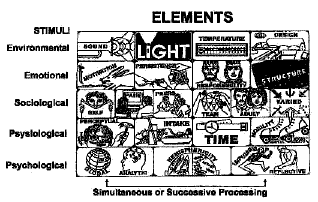
Figure 3. Learning Styles Model developed by Rita Dunn.
Bernice McCarthy is the developer of the 4MAT system, which is shown here.
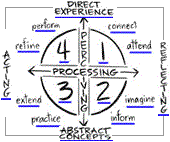
Figure 4. Types of learners in the 4MAT system. See page 202 for further details and reference.
We recommend you visit the 4MAT site About Learning. At the site you will find resources that you can use with your students to help them implement 4MAT.
The last part of this section on learning styles focuses on meta-cognitive strategies including:
- Mind mapping
- Illustrating and drawing
- Brainstorming
- Planning strategies
- Generating questions
- Evaluationg
- Teaching capability
- Communication skills
- Journal keeping
These strategies are tools that students can use to help them understand about their own thinking, and they in turn can apply this to their own classrooms by implementing one or more of these strategies as part of their course syllabus.
SECTION 2: SCIENCE TEACHER GAZETTE
Research Matters: Constructivism as a Referent for Science Teaching by Anthony Lorsbach and Ken Tobin.
Case to Consider: Theory of Science Teaching (on the Companion Website)
In this case a beginning teacher (with a provisional teaching certificate) is puzzled that another beginning teacher could possibly be trying to implement a theory of teaching, when surviving the first two weeks was the order of business. This is a great case to discuss because it will bring to the surface a variety of concerns that beginning teachers have for issues such as classroom management, discipline and paperwork.
Case to Consider: The Student Who Thought He Failed (On the Companion Webiste
In this case the discussion focuses on the use of pre-assessements (as part of a cognitive theory of teaching), and the impact they have on students' views of themselves as science learners.
Science Teachers Talk (on the Companion Website)
In this Science Teachers Talk column, How do you accommodate students' varying learning styles in your classroom?
Problems and Extensions
There are 6 P & E's in this chapter, anyone of which would provide the seed for a great classroom activity and discussion. For example, P & E no. 5 asks students to design a model of learning based on their work in the chapter and from their prior experiences. This is a good advance organizer for the next chapter in which the theories they have looked at here lead to models of teaching and leanring.
Readings
Here you will find a collection of readings on theory in science teaching. You might want to look at the Journal of Research in Science Teaching, Vol. 38 no.3. There are several papers in this issue that focus on theory and science teaching.
On the Web
You will find Five links for this chapter. I've added additional ones focusing on learning styles and the 4 MAT system.
Chapter 8
Syllabus Helper
This chapter is correlated with Chapter 7, in which ideas of several theorists explaining how students learn were presented. This chapter presents models of teaching based on those theories of learning. The models presented here are the scaffolding that will be helpful to your students as they begin to plan lessons and create an environment in the classroom that fosters active student involvement. Underlying all of the models presented is the notion that students should be involved.You can start anywhere in the chapter. Each model has its own protocols, and can be implemented using the material in the chapter.
| Pedagogical Tool | Highlights/Content | Notes |
|
Initial Case Study |
Descent from Innocence |
A teacher has a rude awakening when he attempts to implement a hands-on, inquiry-oriented lab. |
|
Invitations to Inquiry |
Focus questions for the chapter |
The focus questions reinforce the idea that this chapter is practical in nature, and that there are multiple models of teaching that can be implemented in science teaching. |
|
Inquiry Activities |
Inquiry Activity 10.1: Designing Project-Based Activities Inquiry Activity 10.2: Science Teaching as Inquiry |
Students design a science project based on the constructivist model of teaching Students read an article from the Science Teacher on inquiry, and then observe "inquiry" videos on the Annenberg Media site. |
|
The Models of Teaching |
Constructivist Model of Conceptual Change Sociocultural Models: The Role of Collaboration
Inquiry Teaching Direct-Interactive Teaching Model Other Models (on the Companion Website)
|
Each of the models listed to the left has its own protocols and examples. We've given specific details for each model in the chapter so that they can be implemented with peers and in the school environment. |
|
Lessons (on the Companion Website) |
Learning Cycle Lesson 1 Learning Cycle Lesson 2 |
What can be learned from skulls? What caused the water to rise? |
|
Science Education Literature (on the Companion site) |
Breaking into Inquiry by Charles Eich, et.al. |
An important piece of research on why teachers should consider inquiry teaching; details on how to go about doing inquiry in the classroom |
|
Science Teachedrs Talk (on the Companion Website |
Teachers discuss: What are some of the best ways tdo get your students thinking in your science class? Is the discovery or inquiry model of teaching important in your approach to teaching? Why? |
Hear from many teachers on these two questions. |
|
Problems and Extensions |
Sample problem and extension: One criticism of inquiry and disovery methods of science teaching is that this approach takes too much time, and students can learn concepts and skills is presented more directly. Debate this criticism by first taking the side of inquiry and then the side of direct teaching. In which were you more convincing? Is there a solution to this problem? |
This and the other P & E's can be used to involve your students in applying in practical situations the major concepts in the chapter. |
|
Readings |
There are many good articles and books on models of teaching. You might introduce your students to the Joyce and Weil book entitled "Models of Teaching." |
|
|
On the Web |
You'll find several practical teaching websites. |
Agenda Strategies
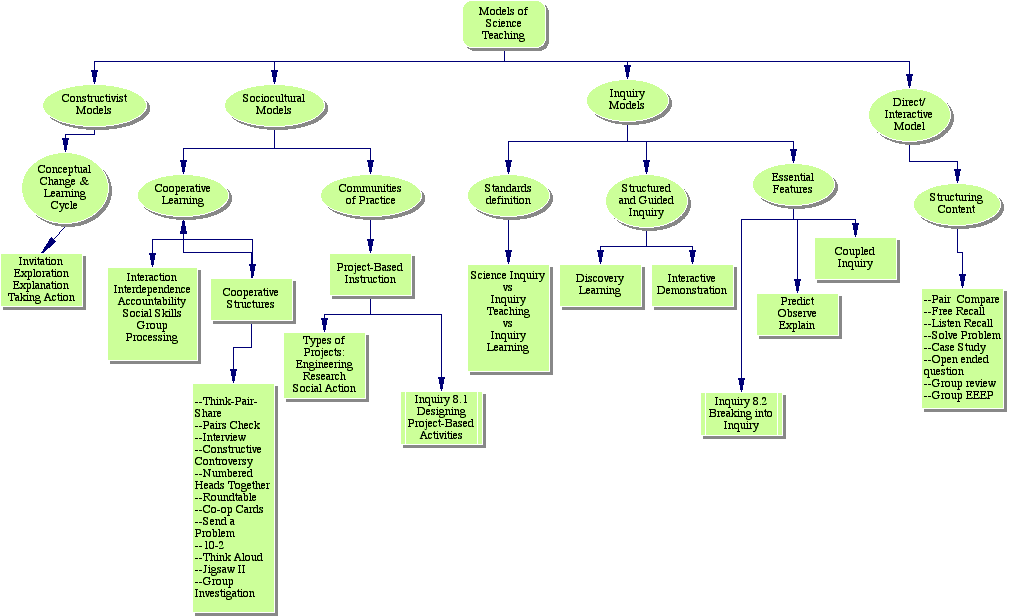
SECTION 1: MODELS OF SCIENCE TEACHING
This chapter is correlated with Chapter 7, in which the ideas of five theorists (Dewey, Bruner, Piaget, von Glasersfeld, & Vygotsky was presented. This chapter presents models of teaching based on those theorists' ideas. The models presented here are the scaffolding that will be helpful to your students as they begin to plan lessons and create an environment in the classroom that fosters active student involvement. Underlying all of the models presented is the notion that students should be involved.You can start anywhere in the chapter. Each model has its own protocols, and can be implemented using the material in the chapter. This and the following chapter are very practical, and have been designed to help your students implement specific approaches to teaching.
Initial Case to Consider: Descent from Innocence
In this chapter, the focus is on practical applications by presenting a number of models of teaching. As science educators, we typically have emphasized an inquiry approach to teaching. But for the beginning teacher, this can be a nightmare. In this case, a teacher, with very good intensions, tries to implemnet a laboratory activity about the metric system. Are the teacher's expectations too high? How would your students suggest the lesson be modified to make it more successful?
Models of Teaching
There are many ways to teach. You and I know that. In this chapter several models of teaching are presented, and with these, we are only scratching the surface of the possible models that have been developed. I recommend that your look at Bruce Joyce's and Marsha Weil's Models of Teaching, which presents a vast array of teaching models. As you can see, I've organized the models along three lines of theory: constructivist, sociocultural, and behavioral.
Models |
Example |
Constructivist |
Conceptual Change |
Sociocultural |
Peer Collaboration & Cooperative Learning Communities of Practice |
Inquiry |
Deductive Inquiry Inductive Inquiry Discovery Open-Ended Inquiry |
Teacher-Centered |
Direct-Interactive Model |
Figure 1: Models of Teaching as They Relate to Theories of Learning
Inquiry Activity 8.1: Designing Project Based Learning Activities
In this inquiry, students will design a project-based activity using the constructivst model presented in the chapter (outlined below). Activities should be based on the learning cycle model and be linked to state and/or national standards.
The Inquiry activity has been placed in the text just after the section on constructivist and sociocultural models of science teaching. It is a design inquiry in which you will be asking your students to inquire into how to develop constructist-based activities. We have provided ample examples in the text that the students can use as referents as they develop their activity.
Following are some comments on constructivist models.
Constructivist Models of Teaching
There are many different models of teaching that can be called constructivist. In our work with the prospective teachers in the program at Georgia State University, the Global Thinking Project, and in seminars for the Bureau of Education and Research, a four-stage model of learning was used as our constructivist template. The four stages were based on the Learning Cycle Model and included the following stages:
- Invitation Phase
- Exploration Phase
- Concept Explanation Phase
- Taking Action Phase
We've found that the best way to help others understand the constructivist model is to have them "construct" a lesson sequence based on the model.
Learning Cycle Lessons
We've included two learning cycle lessons on the Companion Websitde (Learning Cycle Lesson 8.1 and 8.2) that you can have your students read and discuss, or that you could carry out with them and use it for a discussion.
- Learning Cycle Lesson 8:1: What can be learned from Skulls? In this activity students observe a variety of vertebrate skills to make inferences about what it eats.
- Learning Cycle Lesson 8.2: What caused the water to rise? In this lesson sequence, students invert a cylinder over a burning candle placed in a pan of water. Students are asked to predict what they think will happen before they carry out the activity. This would be an excellent activity for you to do with your class to use to help them understand the four phases of the constructivist model, and prepare them for Inquiry Activity 8.1.
|
Title of Lesson
Invitation--finding out about student's prior knowledge Exploration: describe one key activity or inquiry Explanation: how will students hear alternative views and talk aloud about their ideas Taking Action: describe how students will take action or apply new concepts Evaluation: How will student leanring be assessed? Authors: Names of the constructivist design |
|
Inquiry 8.2: Science Teaching As Inquiry
We have designed this activity to enable you to work with your students on the nature of, and implementation issues of inquiry teaching. Two key resources are available to you to use with your students:
1. A Science Teacher article entitled: Breaking into Inquiry by Eich, Meadows, and Balkcom. The article is introduced into the Gazette; the full article can be found on the Companion Website.
2. Links to Annenberg Media Website of videos of science inquiry teaching. There are many inquiry videos to observe at the site. We have focused in on one of the lessons in the Case Studies (case #21---a life science teacher) which you will find at: http://www.learner.org/resources/series21.html#
We recommend that you have your students read the article first (Breaking into Inquiry). They should use the article to compare their own views of inquiry teaching with those that are presented in the article. You might also have the students read the section on inquiry in the Art of Teaching Science.
Use small group work for discussion of the readings.
We recommend that after you have discussed inquiry with your students, have them observe the life science teacher featured in the Annenberg Media video. In it, they will observe a teacher doing inquiry in a lab called the "apple lab." Have your students discuss how the teacher implemented inquiry with his students. Discuss their observations and opinions.
You might follow this inquiry activity up with an activity in which pairs of students design an inquiry activity, and present their product to the class.
Collaborative Learning Models: Sociocultural Theory into Practice (Cooperative Learning)
Cooperative learning is the content of this section, and we've organized the concepts this way:
Cooperative Structures. A cooperative structure is way of organizing the social activity of a group of learners, and as such each structure will result in a slightly different way that students cooperate to learn. You will find many cooperative learning structures described in the text.
Structures I. These structures can be used to organize a lesson that is oriented toward cooperative learning. Anyone of the structures can be used, and in fact, two or more structures can be combined to generate creative lesson plans. |
Structures II. Used in the Direct/Interctive model as a way of accelerating interactivity among your students. Typically these structures follow a presentation (mini-lecture) by the teacher, and are used in a "wait-time" to help students process science concepts and ideas presented by the teacher. |
|
|
Collaborative Models of Teaching. Two distinct approaches are used to organize the cooperative learning models we've chosen here.
- Teacher centered---tutorial models in which students work together to rehearese and learn science information. Models include STAD (on the Companion Website) and Jigsaw (in the text).
- Student centered--problem solving models that engage students in higher order thinking skills. You'll find a discussion of Group Investigation (in the text), and Science Experiences (on the Companion site).
Direct/Interactive Teaching Model
We've presented this an active model of learning, and one that many students will find powerful. It also can be used as an overarching structure for lesson plans. In this regard, the elements of constructivism and cooperative learning can be integrated into the model.
The model shown below lays out the sequence for the direct/interactive teaching model. An important aspect of the direct/interactive model is structuring content. I've outlined several ways that you might want to present to your students. You might assign one of these to each student and ask them to design a lesson which uses the structuring technique to organize the content they are going to teach.
- Whole-to-Part Structuring
- Sequential Structuring
- Combinatorial Organzation
- Comparative Relationships
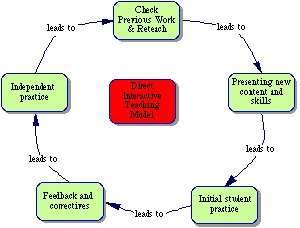
Figure 3. Direct/Interactive Teaching Model.
From Structure to Interactivity. Once students have decided upon how to structure the content, the "cooperative learning structures" described in this section can be used to involve the students in learning teams in one or more interactive modes, e.g. pair and compare; pair, compare, and ask; periodic free-recall, with pair-and-compare. These simple cooperative learning structures infuse direct instruction lessons with a high degree of interactivity.
Inquiry Models of Teaching
What is inquiry? Ask students (in small groups) to identify what is inquiry, and what examples they can give.
Inquiry and the Standards. You might use the material on to outline the notion of inquiry as set forth by the National Science Education Standards. Are these reasonable goals for K-12 students?
Problems with Inquiry. You might read a paragraph or two of the material raising questions about inquiry, and in particular what the researchers quoted here think we should aim for to make inquiry a realistic goal for our students.
Models of Inquiry
Inquiry session. This is a model of the "inquiry session" developed years ago by Richard Suchman. It is described in detail on. One of the keys to an inquiry session is the selection of a discrepant event (or demonstration or EEEP) by the teacher. Note that in this model, the students are engaged by asking questions or proposing theories to explain the phenomenon in the discrepant event.
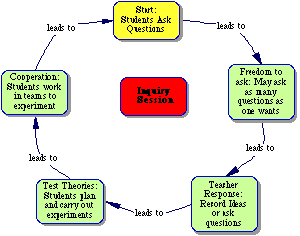
Figure 4. Sequence of an Inquiry Session
Inquiry Activities. I've included a few inquiry-based actiivities that you could assign to small groups of students, who must present them ot the class, and analyze how inquiry is achieved in the activity.
- Inquiry box
- The Wood Sinks and Floats Discrepent Event
- The Coin Drop and Throw
- The Double Pendulum
- The Balloon in Water
Discovery Learning�
We've included a section on discovery learning according to the work of Jerome Bruner, and have included examples of how to implement a discovery approach to learning. You might use the Dinosaur footprint activity (see Figure below) with your students.
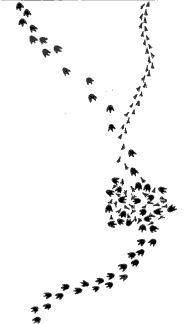
Figure 5. Dinosaur Footprint Puzzle Activity. In this activity students use their observation and inference abilities to interpret "fossil" footprints. These are actually footprints made by dinosaurs perhaps during the Cretaceous Period in central Connecticut.

Figure 8. Dinosaurs during the Mesozoic Era
Other Models of Teaching (on the Companion Website)
We've included four additional models that you might want to introduce to your students. These models come from other disciplines, and provide a broad spectrum to enhance teacher's modes of teaching. The models include:
- Synectics Model. Using metaphors to make the strange familiar and familiar strange.
- Person-Centered Model. The facilitation of learning model developed by Carl Rogers.
- Integrative Learning Model. A model in which sythethis is paramont in learning.
- Imagineering. Model in which imagination is fused with engineering to help students solve problems.
SECTION 2: SCIENCE TEACHER GAZETTE
Science Education Literature: Breaking into Inquiry by Eich, Meadows and Balckom.
This article is integrated with Inquiry Activity 8.2, and is an important piece of literature to help your students on their way toward understanding science inquiry. The full article is accessible on the Companion Website.
Science Teacher Talk (on the Companion Website): What are some of the best ways tdo get your students thinking in your science class? Is the disovery or inquiry model of teaching important in your approach to teaching? Why?
These are important questions, and you might have your students answer the question prior to reading and discussing the question as a group.
Problems and Extensions
There are seven problems that involve students in using different modes of learning and presentation to demonstrate knowledge and understanding about models of science teaching. Anyone of these could be used as a basis for a project on this chapter.
Readings
You will find a collection of readings related to the chapter theme of models of teaching. In addition to the reading in the Research Matters section in the Science Teacher Gazette, these provide a firm basis for understanding the implementation of models of science teaching.
On the Web
You will find several links to sites that will expand your students knowledge of science teaching models.
Chapter 9
Syllabus Helper
| Pedagogical Tool | Highlights/Content | Notes |
|
Case to Consider |
Conversation Among a Teacher and Two Students |
A powerful discussion between two students after they read an article about their teachers research in their own classroom. The students, using Chistroher Emdin's language, compare and contrast two forms of teaching, corporate and communal. |
|
Invitations to Inquiry |
Focus questions for Chapter 9 |
The focus questions outline the key ideas that teachers need to incorporate into the development of teaching strategies and lessons plans. |
|
Inquiry Activities |
Inquiry Activity 9.1: On the Nature of Science PCK Inquiry Activity 9.2: A Window into a High School Teachers Approach to Planning Inquiry Activity 9.3: Designing a Course of Study: The Course Syllabus |
Apply PCK to various domains of science teaching and content from the Standards, Benchmarks, and State Frameworks. Students observe videos of inquiry oriented science teaching and analyze the instructional planning process these teachers used. Learn how to use key course elements to design a syllabus in an area of science |
|
Teaching Units Design Steps |
Part of Inquiry 9.2 outlining the steps for developing teaching plans |
A detailed process that enables students to develop teaching plans constructively |
|
Sample Lesson (Gazette) |
Sample Lesson: Biological Attraction |
This is an example of lesson based on the constructivist lesson model. |
|
Science Teachers Talk (On the Companion Website |
Teachers discuss: Describe your typical process for designing lessons. What tips would you give beginning teachers in planning and preparing lessons? |
Hear what a variety of teachers have to say about planningc, and tips for the beginning teacher. |
|
Planning Activities (On the Companion Website) |
Planning Activity 9.1: Earth Science--Shake, Rattle and Quake: Earthquake Waves Planning Activity 9.2: Earth Science--Don't Take It for Granite: Rock Classification Planning Activity 9.3: Life Science--Light On: Responses of Earthworms Planning Activity 9.4: Physical Science--Chemistry in the Bag Planning Activity 9.5: Physical Science--An Eggzact Experiment |
These five activities are not only science activities that can be used in the K-12 environment, but provide the university professor with applications to science teaching useful in a pedagogical course. |
|
Problems and Extensions |
Sample P & E: Prepare concepts maps for one of the following: a. a chapter from a high school biology, chemistry, earth science, or physics text. b. a potential miniunit on electric circuits, physical and chemical changes, reproduction, erosion, ground water pollution. |
You will find other P and E's that will involve your students in thinking about their miniunit, and how to evaluate it. |
|
Readings |
You will find a collection of science activity books, and resources on teaching strategies. |
|
|
On the Web |
A collection of websites that will bring your students in contact with biology, chemistry, earth science, and physical science resources. |
Agenda Strategies
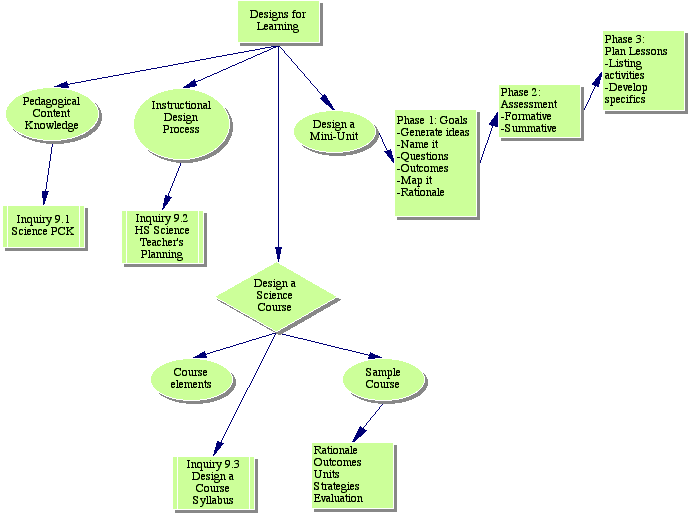
SECTION 1: DESIGNING SCIENCE ACTIVITIES AND UNITS
This chapter has been organized to help students and teachers design a unit of science teaching. The concept of Science PCK (Pedagogical Content Knowledge) is introduced and tied to the development of instructional mateials. A constructivist approach is advocated in the development of science teaching units. Too make the chapter even more practical than it is, I've included a very specific plan to develop teaching materials, and have included sample lessons, and activities that illustrate how to integrate the different theories and models that were presented in Chapter 7 and Chapter 8, respectively.
Case to Consider: Conversation Among a Teacher and Two Students. This case is based on research article that appeared in Cultural Studies of Science Education by Christopher Emdin ("Exploring Contexts of Urban Science Classroom, Part 1: Investigating Corportate and Communal Practices (2007, 2 (2): 319 - 341). Two of his high school students participated in the research by writing some of their views in the journal. It's a powerful article, and will give you students some insights into comparing practices, but from the point of views expressed by high school students.
Nature of Pedagogical Science Content Knowledge
Fundamental to designing science teaching materials is understanding Pedagogical Conent Knowledge (PCK) which is described. It is the principle organizing concept of this chapter. An interesting resource is an online paper by Mark Enfield, Content and Pedagogy: "Intersection in the NSTA Standards for Science Teacher Education."
You will find a table that you can use to present the compoents of PCK, which include:
- Orientation toward science teaching
- Knowledge and beliefs abouit science curriculum
- Knowledge and beliefs abouit students' understanding of specific science concepts
- Knowledge and beliefs about assessment in science
- Knowledge and beliefs about instructional strategies for teaching science
PCK is the integration of one's content knowledge and pedagogical knowledge. You might use Inquiry Activity 9.1 to guide your students into this important concept, and if you are working with experienced teachers, they will benefit greatly from the inquiry, as well.
You might show students this image of fast plants, and ask them how they might use them to teach concepts in biology.
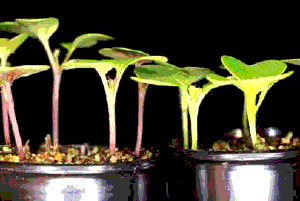
Figure 1. Fast Plants
Inquiry 9.1: On the Nature of Science PCK
In this inquiry your students will select a few goals of science teaching from NSES, Benchmarks, or their state science framework, and then explore how best to help students understand these ideas. The chart below shows how students might organize their ideas in this inquiry.
The links they will need for the activity include:
- NSES
- Benchmarks for Scientific Literacy
- Georgia's State Science Framework (as an example)
Science Concepts from NSES, Benchmarks or State Framework |
Suggestions about how to help students understand these ideas |
Examples of curriculum materials that relate to the identified science concepts |
. |
. |
. |
. |
. |
. |
. |
. |
. |
. |
. |
. |
Inquiry Activity 9.2. A Window into a High School Teachers Approach to Planning. In this inquiry we've linked the inquiry to the Annenberg Media website of videos of inquiry science teaching. We've identified five different teachers, each approaching inquiry teaching. The purpose of the activity is to use these videos to ask your students to reconstruct how the teacher might have planned the activity. This activity can be used as a way to introduce your students to the planning process by looking at lesson planning in the context of real classrooms.
It will enable you to discuss lesson planning and unit development in the context of science classrooms as presented in the videos.
The Design Process: A Constructivist Approach
The approach that is described in this chapter for designing teaching materials has been used and field tested over a period of ten years. The process outlined in the chapter.
We have typically have students develop a science teaching unit over a period of several weeks, and have used the design process outlined in the chapter as the approach. Instead of making the assignment, and having students work on their own, we recommend that you work with them as a group over time to help them create their projects.
The Design Process is broken into three phases as shown in the chart below. The major portion of the chapter is divided into these three phases. We've blended research and practice to show students how professionals design science teaching materials. We've field tested this process with several hundred pre- and in-service science teachers over the past 20 years.
Phase I |
Establishing Goals and Objectives |
Phase II |
Develop an Assessment Plan |
Phase III |
Plan Activities and Lessons |
Designing a Science Miniunit
The figure below shows some of the specific activities that teachers use to develop their mini-unit based on the approach outlined in the text.
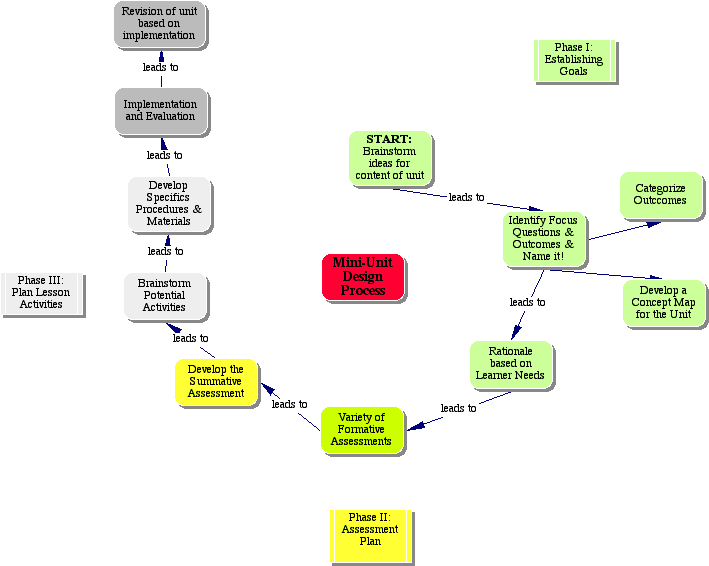
Phase I: Establising Goals
Brainstorm Ideas. Students should work in a planning team to begin the process. It's best if you have an introductory session explaining the assignment of developing a miniunit so that students can give some thought to a topic that might develop into a unit. This step should follow at least an overnight opportunity for reflection on a topic. Within their team, members should brainstorm ideas that relate to the topic.
Name your Science Miniunit. After the brainstorming session, have the students work with each other to generate names for the miniunits that they are developing. A list of examples appears in the text.
Identify Focus Questions. Using the list of ideas, have students generate four to six "focus" questions, questions that should help the students define the heart of their unit. Examples are included.
Identify Intended Learning Outcomes. Students might work back and forth between their initial list of ideas and focus question, and the NSES or the Benchmarks for Scientific Literacy. In the process they should make a list of intended learning outcomes---statements of what they intend that their students learn. Use the chart paper to record their outcomes.
Categorize Intended Learning Outcomes. Using the list of outcomes, have the students make a simple binary category system in which they list them as either nonskill or skill outcomes.
Develop a Concept Map. A concept map is a powerful tool. Now that the students have invested time into their unit and have a deeper understanding of the concepts, they should put their ideas into a concept map.
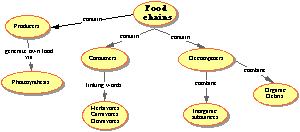
Have them develop the map, and share it with you and their peers for feedback and improvement. Also, the map should be developed as a potential tool that they might use with their students.
Write a Rationale. Writing the rationale is important, and since the students have now been working on the unit for some time, they will be a better position to write a statement that is powerful. They should write their rationale in a language that is directed at the potential students of their miniunit, and it should integrate answers to the questions:
- How does the unit affect the future of the students as well as their individual needs and interests?
- How does the miniunit contribute to societal issues and help students deal responsibily with science-related issues?
- How does the miniunit reflect the spirit and character of scientific inquiry and the nature of the scientific enterprise?
We've included two examples of rationales in the text.
Categorize Outcomes: Cognitions, Affects and Skills. I've used three categories to form a system that I've found very effective with students and teachers. Students should generate outcomes for each of the categories:
- Cognitions. These include concepts and propositions (the student will know the cell theory). The NSES and Benchmarks are powerful resources to help students state their cognitions.
- Affects. These include statements of feelings, values and attidudes. Again the NSES and Benchmarks a good resources.
- Skills. Two categories are included as follows:
- Cognitive Skills. This should represent the bulk of the outcomes in a teaching unit, and these statements will "look like" the objectives that we have been stating for many years, eg. the student will be able to predict the location of the moon in the daytime sky.
- Psychomotor Skills. Laboratory skills should also be included in the miniunit. This section outlines the types of psychomotor skills to include.
Phase II: Develop an Assessment Plan. We explore formative and summative assessment (briefly here---in more detail in Chapter 10). We provide specific examples of each type of assessment, and suggest that the students include examples of each type in their mini-unit.
Phase III. Plan Activities and Lessons. We divide this phase into two activities: listing potential activities, develop specific lesson plans. Specific examples are provided for you to use with your students.
- List Potential Activities. At this stage, potential activities should emerge from the list of intended outcomes. One way to accomplish this, is to use the concept of "instructional foci"---means with which learners will attain the outcomes that were created. We've included examples of instructional foci for students to examine.
- Develop Specific Lesson Plans. We recommend between four and six lesson plans for a miniunit. You will find three different formats for developing the lesson plans as follows:
- Lesson Plan Template Constructivist. For a sample lesson, please see the Science Teacher Gazette.
Implement the Miniuni. If the miniunit is being developed as part of field experience course, then try and have the students implement it with a group of elementary or secondary students. If this is not possible, then I recommend that each student "teach" one lesson (or a part of a lesson) to group of peers, and use the feedback form to obtain information on the effectiveness of the lesson from peers. If you are teaching a graduate level course, teachers can implement the miniunit with one of their classes, and report back to class on the effectiveness of the plans.
Designing a Science Course of Study
This section introduces the student to 5 elements that might be used to design a course of study. Combined with Inquiry Activity 9.3 (Designing a Course of Study: The Course Syllabus), the section should provide useful information on implementing course plans.
You might take time to go over the 5 elements, using the text material prior to having students complete Inquiry Activity 9.3. The elements include:
- Rationale/Philosophy
- Learning outcomes
- Units of Study
- Instructional Strategies (foci)
- Evaluation
To make these elements practical, I've discussed each within the context of a course of study entitled Global Science, published by Kendall Hunt. It's a text based program, thereby reinforcing the notion that most of your students will be designing courses of study based on a text. If you go to the Kendall Hunt webiste, you will be able view more information about the text, Global Science.
Inquiry 9.3: Designing a Course of Study: The Course Syllabus
This activity is powerful in the context of a field experience, such as an internship, or if you are teaching a graduate course for teachers, then the activity might be way for the teachers to reflect on the course syllabi that they have created for their courses. Have students work in small teams (2 or 3) for brainstorming and disucssion purposes. The "data" generated in these small teams will be a strong base for the development of syllabi by individuals.
Follow the procedures as identified on page 289. Try and have on hand potential textbooks that students will use to develop their course syllabi. After the syllabi are created, take a session for students to share their results in small groups, and then use the Minds-On Strategies on p. 289 for a discussion.
SECTION 2: SCIENCE TEACHER GAZETTE
Science Teachers Talk (On the Companion Website)
Teachers disucss this topic: Describe your typical process for designing lessons. Also in this teacher talk session, Virginia Cheek, Ben Boza, Rachel Zgonc, Jerry Pelletier, John Ricciardi, and Ginny Almeder provide tips that give to beginning teachers on lesson planning and preparing lessons. Rachel Zgonc was a first year teacher when she wrote her comments; the other teachers are all veteran educators.
Planning Activities (On the Companion Website)
We've provided five "planning activities" and put them all up on the Companion Webiste. The "applications to science teaching" section of each planning activity is designed to have the students reflect on science teaching. If you do any of these activiies this section will provide a powerful way to extend the students understanding of science education.
- Planning Activity 1: Shake, Rattle and Quake: Earthquake Waves
- Planning Activity 2: Don't Take It for Granite: Rock Classification
- Planning Activity 3: Light On: Responses of Earthworms
- Planning Activity 4: Chemistry in the Bag
- Planning Activity 5: An Eggzact Experiment
Problems and Extensions
The P & E's for this chapter include questions on evaluation, objectives, and concept maps. They could be used for classroom activities, or extensions beyond class.
Readings
You will find a selection of science education "activity" books that will be useful to students as they develop their miniunits.
On the Web
The websites choosen bring the students into contact with the major organizations in biology, chemistry, earth science, physics, and the standards.
Other Stuff- On the Companion Site
- Chapter Powerpoint Presentation
- Science Teachers Talk: Describe your typical process for designing lessons. What tips would you give beginning teachers in planning and preparing lessons?
- Planning Activities: Earthquakes; Classifying Rocks; Animal Behavior; Chemistry in the Bag; and An Eggzact Experiment�
Chapter 10
Syllabus Helper
This chapter presents assessment from three vantage points: the classroom level, the national level, and the international level. This approach will provide your students with specific strategies to use to assess classroom instruction, as well as inform them about recent emphases on national and international comparisons of science progress. To augment the constructivist approach advocated in previous chapters, this chapter presents assessment tools for an active learning environment.
| Pedagogical Tool | Highlights/Content | Notes |
|
Initial Case Study |
Mrs. Cronin's Whirlybird Project: Assessment in Action? |
A teacher uses a laborabory activity as a way to assess student thinking. A group of college interns question the strategy. |
|
Invitations to Inquiry |
Focus questions for the chapter |
The focus questions outline the key ideas that teachers need to incorporate into knowledge about assessment. |
|
Inquiry Activities |
Inquiry Activity 8.1: Designing an Assessment Plan Inquiry Activity 8.2: Designing Performance Assessment Tasks |
Design an evaluation plan for a unit of teaching. Design a performance task to assess a big idea in science. |
|
Case Study on the Companion site |
The False Crisis in Science Education, |
Is there really a crisis in education? A reporter's remarks spark a debate on this question. |
|
Science Education Literature on the Companion Site |
Science Literacy: Lessons from the First Generation by Marlene M. Hurley |
The author sheds light on the issues related to science literacy and illiteracy. |
|
Problems and Extensions |
Sample P & E: What are examples of performance assessments in life science? Can you give examples from physical, earth and STS? |
Problems and Extensions provide opportunities for further research on assessment issues. |
|
Readings |
Key pieces of literature related to assessment. |
|
|
On the Web |
You will find links to several assessment sites. |
Agenda Strategies
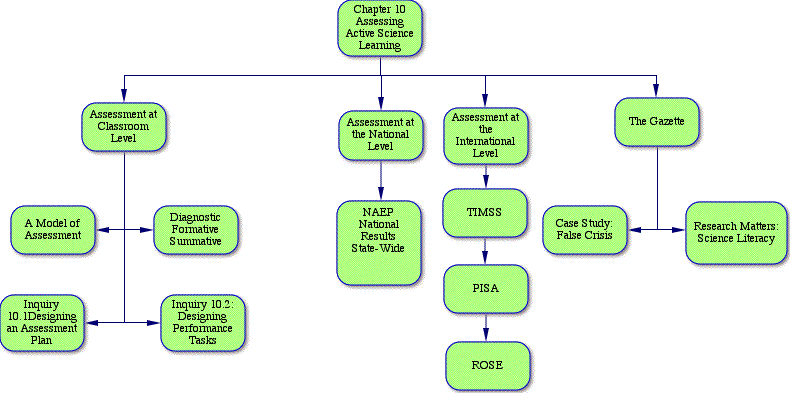
SECTION 1: ASSESSING ACTIVE LEARNING
This chapter presents assessment from three vantage points: the classroom level, the national level, and the international level. This approach will provide your students with specific strategies to use to assess classroom instruction, as well as inform them about recent emphases on national and international comparisons of science progress. To augment the constructivist approach advocated in previous chapters, this chapter presents assessment tools for an active learning environment.
Initial Case to Consider: Mrs. Cronin's Whirlybird Project: Assessment in Action?
How should student learning be assessed by classroom teachers? This case study helps raise this question by having your students assess an evaluation procedure used by a classroom teacher--namely performance assessement. In the case, a group of preservice science teachers observe a teacher in action doing the "Whirlybird project" with her students. It's a hands-on activity, and the teacher explains that she is using it as a "test" or assessment procedure.
Use this case study to begin the chapter, because it will help you preview the prior experiences your students have with assessment, and their attitude toward performance assessement.
A Model for Assessment
The NSES and the Benchmarks presents a vision of a scientifically literate populace as the goal of science education. You might use the questions posed on page 302 to discuss with your students their views on a model for assessment. The questions guiding a model would include:
- Where are you trying to go?--identify and communicate the learning and performance goals.
- Where are you now?--assess, or help the student to self-assess current levels of understanding.
- How can you get there?--help the student with strategies and skills to reach the goal.
Assessing Classroom Learning
We've organized the section of classroom assessment into three categories of methods: diagnostic, formative, and summative, and you might use them to organize a brief overview of assessment in the classroom. They include:
Diagnostic Methods of Assessment
Assessing Students' prior knowledge is explored in this category, and we've included a number of ways that pre-service teachers can use to diagnose students' ideas about the topics and concepts they are teaching including: Group T-Charts, Pictorals and Drawing, Concept Mapping, ande Probing Activities.
The T-chart is a strategy that can be used to assess students' prior knowledge. The chart below shows a T-chart developed by a team of 7th grade students on the topic of ozone.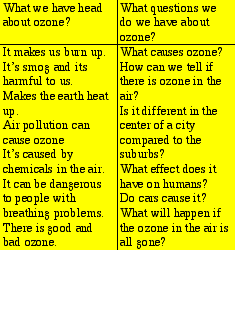
Formative Methods of Assessment
We've provided a number of strategies that teachers can use to assess and provide feedback on student understanding. Here are a few of them.
- Observing Students
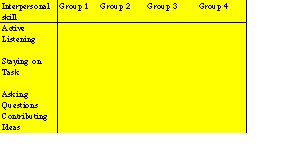 Table 10.1. Observing student informally in small groups can be accomplished by using a chart such as the one shown here.
Table 10.1. Observing student informally in small groups can be accomplished by using a chart such as the one shown here. - Asking Questions
- Student Questions
- Conferencingc
- Monitoring Classroom Practice
- Homework
- Alternative Paper and Pencil Tests
- Traditional Paper-and-Pencil Tests
- Traditional Short Answer
- Web-Based Formative Assessments
- Student Writing
- Open-Ended Questions
- Content-Specific Tasks
- Science Journals
- Written Reports, Video or Multimedia Presentations
Summative Methods of Assessment
- Performance-Based Assessment---There are several performance examples in the text. Here is another one for your use with your students.
�
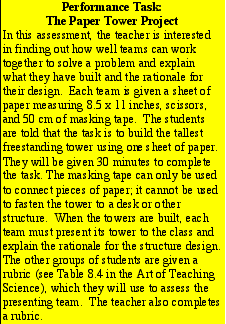
Portfolios--We've included material on the development of portfolios for secondary students. A powerful example is included for your use with your students and you will find in the Gazette of this chapter.
Inquiry Activities
There are two Inquiry Activities in this section that you can use to organize the content of this section, and they are:
Inquiry Activity 10.1: Designing an Assessment Plan
This inquiry activity is designed to be used in conjunction with a miniunit or unit of teaching that your students have developed. The students will have to make use of the content presented on the types of assessement methods: diagnostic, formative, and summative.
Inquiry Activity 10.2: Designing Performance Assessment Tasks and Rubrics
In this inquiry you are going to lead the students in the development of a performance assessment. You might have the students read the section in the text on performance assessment, and note the examples. We recommend that you have students work in teams to develop the performance assessment, and then present to their peers.
In the inquiry, students should select a Big Idea from Table 10.8 in the text which was developed by identifying one idea from the 8 content areas from the National Science Education Standards.
Assessing Science Learning at the National Level
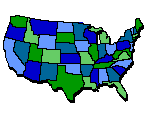
We recommend that you preview the Nation's Report Card website which will provide information and graphics that you can use with your students to explore the Federal Government's program of long- and short-term assessment of educational progress.
You can examine the year 2000 results online, as well as read abouit them in The Art of Teaching.
Long-term Trend Assessment
Since 1969, the National Assessment of Educational Progress (NAEP) has conducted a series of assessments involving students at various grade levels every 3 - 5 years (in science). The assessments looked at achievement, attitudes, and experiences in science.
Proficiency Levels and Test Items
To examine trends and make comparisons, the NAEP established five levels of proficiency, and designed test items for each level, and used these levels to design tests at various age levels, e.g. 9, 13 & 17.
�
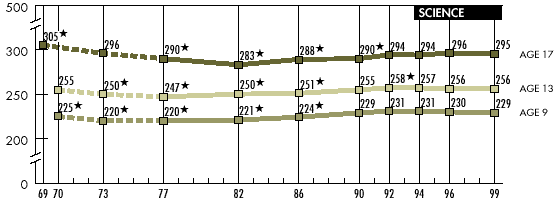
Figure 10.1: Trends in Average Scale Scores for the Nation in Science
Urban Science Assessment. NAEP has also begun to design assessments for the nation's largest school districts. We've reported on this, and you might find this interesting to discuss with your students.
State Wide High Stakes Assessment. The number of states that use high stakes "graduation" asessments has grown, and so have the problems and issues associated with this trend. We've reported on this, and also cited authors who criticize this trend with data.
Assessing Science at the International Level
We have featured and reported on three international assessment projects. We have provided specific information about each type of assessment.
TIMSS--Trends in Mathematics and Science
PISA--Program for International Student Assessment
ROSE: The Relevance of Science Education
Issues of Concern: There are controversies surrounding the use of large scale international (and national) assessments. We discuss some of the issues, which you will want to discuss with your own students.
SECTION 2: SCIENCE TEACHER GAZETTE
Think Pieces
The think pieces for this chapter provide questions that focus on a range of issues regarding assessment, from the classroom level, to the national and international level.
Case Study: The False Crisis in Science Education
In this case, which is described on the Companion Website, a reporter challenges the status quo that there is a crisis in science education. Her comments are used to engage your students in a debate about the status of science education.
An excellent article published in Scientific American (October, 1999) related to this case is "The False Crisis in Science Education," by W. Wayt Gibbs and Douglas Fox.
Research Matters: Science Literacy: Lessons from the First Generation by Marlene M. Hurley (Please go to the Companion Webiste)
This paper provides a brief overview of the concept of science literacy through its conceptual lineage and current research. A few websites mentioned in the article include:
Problems and Extensions
You might want to use Problem and Extension #4 to link with the countries featured in Chapter 5 (Australia, Chile, China, Ghana, Japan, Russia, Turkey) in terms of international assessment results.
Readings
You will find several key books on the recent trends in assessment listed here.
On the Web
The Web contains a multitude of resources on assessement. I've included a few for quick links.
Chapter 11
Syllabus Helper
Three major ideas are developed in this chapter: strategies for interactive teaching, strategies for establishing a culture of learning, and strategies fostering independent and collaborative thinking. Teachers will be able to implement many of these strategies into the classroom and consequently you will want to return to this chapter from time to time. The chapter also includes a section on language and learning science, with specific strategiies on talking about, reading, and writing about science. The last section explores the importance of problem solving in the context of independent and collaborative thinking.
| Pedagogical Tool | Highlights/Content | Notes |
|
Initial Case to Consider |
The Learning Log |
A teacher is excited about implementing a writing-to-learn project, but finds one of his colleagues thinks its a waste of time. A debate follows. |
|
Invitations to Inquiry |
Focus questions for the chapter |
The focus of this chapter is strategies that foster thinking in the science classroom. |
|
Inquiry Activities |
Inquiry Activity 11.1: Microteaching: Practicing Science Teaching Skills |
A strategy for laboratory approach to learning science teaching skills. |
|
Sample Lessons |
Lesson 11.1: Earthquakes Lesson 11.2: Crusty (Rock) Writing Lesson 11.3: Using the Learning Log with a Hands-On Activity |
Using the K-W-L method Science and poetry Integrating writing into a hands-on science activity |
|
Science Teachers Talk (On the Companion Website) |
Teacher's discuss: What strategy of instruction do you find to be the most effective with your students? |
Read what science educator's Tom Brown, Rachel Zgonc, John Ricciardi, and Mary Wilde describe as their most effective strategies. |
|
Case to Consider (On the Companion site) |
Questioning: Inquiry or Inquisition? |
What attitude should teacher's express when asking and listening to student responses. Find how "Joe Ellis" deals with this in his classroom. |
|
Research Matters (Full articles on the Companion site) |
Using Questions in Science Classrooms by Patricia E. Blosser When are Science Projects Learning Opportunities by Marcia C. Linn and Helen C. Clark |
A classic piece on the questioning strategy and science teaching. An important piece on how projects are important in science teaching. |
|
Problems and Extensions |
Sample Problem and Extension: Present a demonstration, teaching tool, simple lab activity, creative homework assignment, or strategy or technique related to one of the following areas of science teaching: earth science, life science, physical science, or STS. |
The 11 P & E engage students in problems that focus on strategies of teaching science. |
|
Readings |
A selection of readings that focus on strategies of teaching. |
|
|
On the Web |
A collection of sites you might want to use to extend students' knowledge of strategies of teaching. |
Agenda Strategies
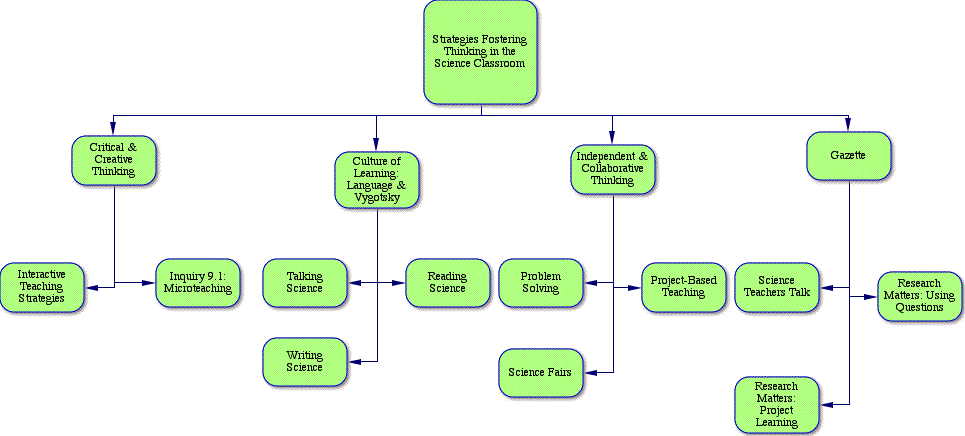
SECTION 1: THINKING IN THE SCIENCE CLASSROOM
Three major ideas are developed in this chapter: strategies for interactive teaching, strategies for establishing a culture of learning, and strategies fostering independent and collaborative thinking. Teachers will be able to implement many of these strategies into the classroom and consequently you will want to return to this chapter from time to time. The chapter also includes a section on language and learning science, with specific strategiies on talking about, reading, and writing about science. The last section explores the importance of problem solving in the context of independent and collaborative thinking.
Initial Case Study: The Learning Log
Should writing play a prominent role in science teaching? In this case, your students are asked to try and develop a convincing argument to support this approach. This is a good lead into the chapter, especially with regard to a later section in the chapter entitled: "Establishing a Culture of Learning: Language and Vygotsky."
Strategies Fostering Critical and Creative Thinking
We've put together a collection of teaching strategies that will help you reach the goal of encouraging your students to think critically and creatively. Thinking is a holistic process, and although we have identified "thinking processes" that might be characteristic of critical thinking and creative thinking, each contributes to human thinking.
Interactive Teaching Strategies
We've gone into some detail about several "interactive" teaching strategies that you many want to introduce to your students. You can model any of these yourself, and then integrate them into the microteaching inquiry (Inquiry Activity 9.1) in which your students plan and teach mini-lessons to their peers. Students can then teach a lesson and "practice" one of the "interactive" strategies as a function of the lesson. For example, a student might choose "advance organizers" and then plan a lesson that showcases how they use this particular strategy. We recommend that they not try and use more than one at any time in the microteaching enivonment.
- Advance Organizers--presentation of information (verbal or nonverbal) at a higher level of abstraction that science material to follow.
- Creating a Stimulating Classroom Environment---using a variety of teaching skills to promote iinteractivity.
- The Art of Questioning--knowing how to use questions to promote inquiry and thinking among your students.
- Using Examples to help Students Understand Science Concepts---knowing how to use examples inductively and deductively to help students understand science concepts.
- Positive Learning Environment---creating an empathic learning environment.
- Closure and Making Transitions---the art of making connections and moving from one part of a lesson to another.
Inquiry Activity 9.1: Microteaching: Practicing Science Teaching Skills
In this inquiry, students prepare a science lesson (micro-lesson) that can be taught in 5-10 minutes (of course, you can change the time allotment as you deem). The lesson should be used to "explore" the interactive teaching skills presented in this section, e.g. Advance Organizers, Creating a Stimulating Classroom Environment, The Art of Questioning, Using Examples to help Students Understand Science Concepts, Positive Learning Environment, and Closure and Making Transitions.
Assign students to small teams (about 5 per team), and tell all students that they should be prepared to teach their lesson at the next class sesson. Within each small group, students can teach their micro-lesson to the remaining 4 students (one of whom has been identified as the coach. Prior to the lesson, the designated teacher should meet with the coach to identify the goals of the lesson, and what to look for. The pair should meet after the lesson is taught to review the video of the lesson. If you choose to do a "re-teach" sesson, you will have to re-group students so that they have different "learners" to teach.
Establishing a Culture of Learning: Language and Vygotsky
According to researchers, bringing a variety of language (or linguistic) modes is fundamental to helping students construct ideas: listening and talking; reading and writing; discussing and arguing; narrating and describing; using actions, images, and symbols.
This section emphasizes the importance of the work of the Russian psychologist, Lev Vygotsky. To Vygotsky and his propents, the social context and language are the essence of learning. You should have your students read the section on Vygotsky and go to a Vygotsky web site.
Three language modes are emphasized. You will note that I've included practical activities that your students can use with middle and high school students: talking science, reading science, and writing science. I hope you will find this section also practical for your own college level or seminar classroom.

A reference that we found useful in putting this section together is Jones, Carys, 2000, "The Role of Language in the Learning and Teaching of Science," in Martin Monk and Jonathan Osborne (eds). Good Practice in Science Teaching: What Research Has to Say. Buckingham, UK: Open University Press, pp. 88-103.
Talking Science
Talking is as essential to learning as making observations is to the process of science. However, as cited in this section, talking by students in infrequent, and often the response to a question by the teacher. Talking is important because it enables teachers to find out about student prior knowledge, and world view. I've outlined several strategies you might use with your own students so that they can see how these strategies work among themselves. These include structured controversy, open-ended questions, think-aloud pair problem solving, and using science stories.
- Structured Controversy
Here is a graphic that you might use to introduce structured contoversy---a strategy that encourages academic conflict and discussion. The strategy involves developing materials on a controversial issue (see the listing of issues below), and then conducting the "debates" as small group discussion sessions.
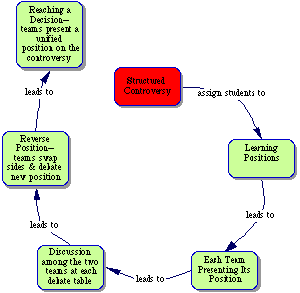
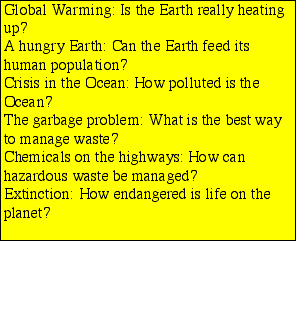
Reading Science
One of the challenges for science teachers is to make reading an active process, rather than the prevailing passive nature of reading, especially when textbooks are the main sources of reading. This section highlights an active approach, and includes several strategies including: listening, coming to terms---the vocabulary problem, reading for meaning and understanding (K-W-L strategy), and semantic mapping.
To provide practical examples, I've included a few sample lessons in this section, and in the next on "writing science."
Sample Lesson: Earthquakes
This lesson, about earthquakes, using the K-W-L strategy, and can be used a model for other content lessons using the strategy.
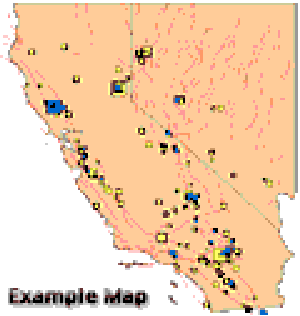
�
Writing Science
Writing helps students reconstruct knowledge and ideas, and is a powerful tool in the classroom. Again, the problem is designing interesting writing activities. Several practical strategies, as well as sample lessons are included in this section. We've suggested several strategies you might want to use: writing to learn (see sample lesson 8-2), web-writing (email projects, bulletin board discussions, and web page design), science logs (see sample lesson 8.3), science newspapers, and storywriting.
- Writing-to-Learn
- Sample Lesson Crusty (Rock) Writing
In this lesson, science observations and notes are used to encourage the students to write a poem about rocks.
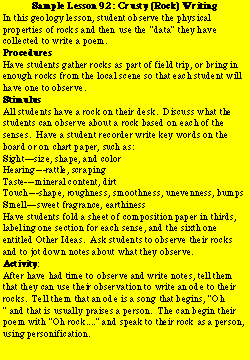
- Learning Logs
Perhaps one of the most powerful writing tools is the use of the learning log or science journal. Logs can be used as a note taking devise, as a record of experiements and activities, as a vehicle to write dailing reflections, and as a learning tool. Sample lesson 8.3 shows one way to use a log.
- Sample Lesson: Using the Learning Log with a Hands-On Activity
In this activity, the learning log is used as a tool to record, and reflect on a science demonstration or discrepent event.
Strategies That Foster Independent and Collaborative Thinking
I've highlighted two strategies here, problem solving and science fairs.
Problem Solving
- Project-Based Science Teaching
I recommend that you take a look at Joseph Polman's book on project-based science teaching (Polman, Joseph L., 2000, Designing Project-Based Science. New York: Teachers College Press). You can also obtain resources on project-based science teaching at this web site. In the text you will find a collection of science projects (view on the web) in each of the categories. These are practical examples of problem solving, and should be of value to your students in the development of lessons and units of teaching.
- Life Science Projects
- Physical Science Projects
- Earth Science Projects
Science Fairs�
Science fairs can be a powerful way to involve some of your students in science. You might scale the model down to the classroom level, and use it with various units of teaching, or as a major "project" for a semester course. Send you students to Science Fair Central for information and ideas.
SECTION 2: SCIENCE TEACHER GAZETTE
Case to Consider: Questioning--Inquiry or the Inquisition? (On the Companion site)
How should teachers ask questions? Is it a good practice to ask students who you know won't be able to answer? This case brings this issue to the table. The Research Matters article by Patricia Blosser, Using Questions in Science Classrooms might be used in conjuction with this case study.
Science Teachers Talk: What strategy of instruction do you find to be the most effective with your students? (On the Companion site)
Several teachers discuss this question. You might want to ask your students at the beginning and the end of this chapter to discuss this question.
Research Matters: Using Questions in Science Classrooms by Patricia E. Blosser
This is a classic piece written by Patricia Blosser who contributed many research papers during her work at The Ohio State University.
Research Matters: When are Science Projects Learning Opportunities by Marcia C. Linn and Helen C. Clark
This is a key piece of research written by two outstanding researchers on the value and criteria for science projects.
Problems and Extensions
I've included a wide range of P & E's focusing on strategies of science teaching that you can use as classroom activities, online discussion starters, or individual project work.
Readings
There are several articles that provide practical examples of using innovative strategies in the science classroom.
On the Web
A collection of websites that should enhance your students' work with outstdanding strategies of science teaching.
Chapter 12
Syllabus Helper
The chapter is organized around several themes: student experiences with the Internet (powerful activity structures for using the Net), telecommunications projects and student inquiry(case studies and examples of internet-based projects that involve students in authentic inquiry).
| Pedagogical Tool | Highlights/Content | Notes |
|
Initial Case Study |
Web-Based Teaching, Just Another Progressive Education Fad? |
A science teacher questions a science education researhers assertion that the Web might be one of the keys to reforming science education. |
|
Invitations to Inquiry |
Focus questions for the Chapter |
Key questions inviting your students to learn about the Internet and science teaching.s |
|
Inquiry Activities |
Inquiry Acitivity 12.1: Exploring Internet-Based Pedagogies Inquiry 12.2: Network Science---Exploring Online Projects |
Using Web-based pedagogies to create an online science activity Analyzing the attributes of four online science projects |
|
Emerging Pedagogical Practices |
Computer-mediatied communication Computer-supported collaborative learning Wireless interactive learning devices |
Details and examples of how information and communication technologies are used in classrooms |
|
Web-Based Innovations |
Innovations:
|
These innovations provide the basis for the development of multiple ways to use the Internet for face-to-face or Web-based teaching. Specific examples are given with examples of how you can use these innovations with your students.s |
|
Network Science Inquiry Projects |
|
A section on Network science in which the attributes, implications and examples are discussed. Inquiry 12.2 is integrated into this section enabling your students to "experience" four different network science projects.l |
|
Web-Based Projects |
Examples of Web-based projects: |
Links to projects that located on the artofteachingscience.org website. |
|
Science Teachers Talk (on the Companion Website) |
Teachers discuss: How do you use technology (including the Internet) in your science class? Why do you, and what do you see as the benefits for your students? |
An interesting discussion of how teachers from four different countries use technology and the Net in teaching. |
|
Problems and Extensions |
Sample Problem and Extension: Discuss the implications of usingc the Web to make your teaching environment a "global classroom." What do you think will be the outcomes and benefits for your students and colleagues? |
You'll find six P & E's that you can use as classroom activities, online experiences, or for discussion. |
|
Readings |
Key Internet readings to expand the horizons of your students. |
|
|
On the Web |
Key Websites for the content of the chapter. |
Agenda Strategies
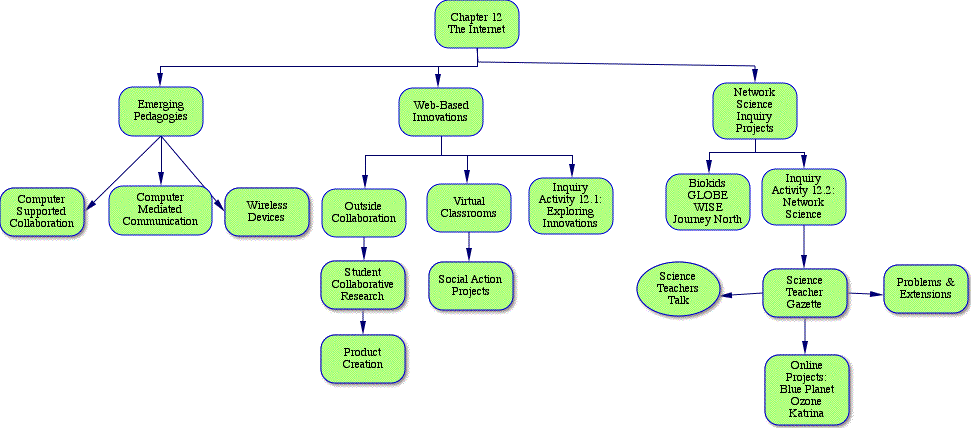
SECTION 1: WEB-BASED LEARNING ENVIRONMENTS
The chapter is organized around several themes: student experiences with the Internet (powerful activity pedagogies for using the Net), network science projects, and student inquiry(case studies and examples of internet-based projects that involve students in authentic inquiry).
Initial Case Study: Web-Based Teaching, Just Another Progressive Education Fad?
A science teacher questions a science education researhers assertion that the Web might be one of the keys to reforming science education. This is an important case because it is a cautionary note about the euphoria that sometimes surrounds the use of technology in education.
Creating a Web-Based Classroom
You might want to use the brief biographical information about Tim Berners-Lee and his mantra for the using the web, "mind to mind." Berners-Lee, the inventor of the WWW, envisioned the Web as communication through shared knowledge via collaboration among people at work or at home.
Emerging Pedagogical Practices
We focus here on how information and communication technologies are used in the classrooms. Three pedagogical practices are presented:
- Computer-mediatied communication
- Computer-supported collaborative learning
- Wireless interactive learning devices
We've provided information and Web-links to projects that utilize each of the practices.
Inquiry Activity 12.1: Exploring Internet-Based Pedagogies
In this inquiry, students design a web-based activity based on one or more of the Web-Based pedagogies discussed in the text. We recommend that you first work with the students by giving an overview of the Web-based tools. Then have the students identify a goal (STS, science inquiry or science concept) which will be used to develop a Web-based activity using one or more of the web-based tools.
Web-Based Innovations
W've identified a number of web-based pedagogies that you can present to your students as ways that the Internet is being used in classrooms around the world. We've worked with all of these for years, and have found them to be practical and powerful experiences for students.
Outside Communication with Peers and Experts
- Keypals and Global Classrooms--linking individuals (keypals) or classrooms at distant locations to collaborate with each other.
As seen in the map below, keypals and global classrooms takes advantage of the web in bringing teachers and students together to participate in collaborative projects, inquiries, and activities in which information is shared among participants.
Have your students read the section on keypals and global classrooms, and discuss implications for practice.
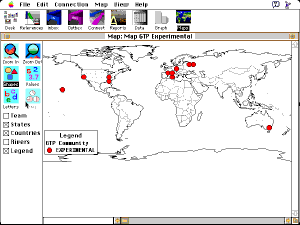
Figure 12.1: Global Classrooms--The map shows locations of schools that collaborated with each other as 'global classrooms' by sharing information about different environmental issues.
Keypal/global classroom helpful links:
- E-Pals Classroom Exchange--particiapte in cross-cultural activities
- The Global Schoolhouse--one of the original sites fostering worldwide collaboration
- Yahoo Groups--resource for setting up your own groups
- Telementoring--Experts and Question-and-Answer Services--tools to link students with experts and resources created by experts.
In the text we discuss how telementoring can contribute to the goals of a science program by involving students in career opportunities, and involving students with experts in the field. The two sites that are identified below will provide ample resources to help your students design telementoring/expert activities.
- Ask an Expert--provides access to an inventory of "ask-an-expert" sites in general science, astronomy, biology, physics, oceanography and more.
- Scientific American Ask the Experts--access to current questions and answers and an archive
Student Collaborative Research
- Pooled Data Analysis (Network Science)---perhaps the most powerful tool for helping students understand science inquiry, Pooled Data Analysis, A.K.A. "Network Science" typically involves students in the inquiry of a phenomenon (cloud coverage, bird migration, stream analysis, air pollution, soil erosion, etc.), but in collaboration with students at distant sites. I was involved with the creation and development of the Global Thinking Project and the Eco-Connections Project during a 15 year period in which teams of teachers and students from several continents worked together to study global environmental problems. The prototypes explained in the text were field-tested in each of these projects, and many others.
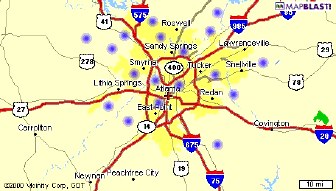
Figure 12.2: Pooled data analysis does not have to involve students from different countries. In fact the blue dots represent the addresses of students in one of my summer courses at Georgia State University, located in Atlanta. At their homes, they collected data for several days on ground level ozone, posted their data on class data table online, and participated in an online discussion of the results, and then followed-up by participating in a face-to-face analysis and discussion of the data and implications for the quality of air in the Atlanta area. This is clearly something that you can do with your students in your classes, or if you are teaching an online course, this project will work beautifully with the students, since they are at distant sites. You can link to Project Ozone.
- Virtual Field Trips---This is a popular use of the Web in that teachers can engage their students in online virtual field trips by visiting online museums of science, or participating in scientific expeditions (such as The Jason Project). Useful sites for viritual field trip include:
Product Creation and Web Publishing
Publishing on the Web is a powerful way to involve students in communicating the results of their work. Students can publish web pages that summarize their work, or describe the details of projects, and classroom activities. Teachers can use the web to organize instruction, communication among students, and contact with parents.
Social Action Projects---Social aspects of science and science-related social issues provide the basis for social action projects. Social action projects typically are interesting to students because they involve students not only in a science project, but one that engages them in issues that may have personal meaning to the students. I recommend you explore the IEARN site which is linked below:
The Virtual or Online Classroom--The Web can be used to teach entire courses online, or in hybrid form, to provide Web resources for the students in a face-to-face course. As you know more and more states and school districts are now offering students the choice of taking courses online instead of face-to-face courses. There are a number of resources that I have found useful in introducing teachers to world of the virtual or online classroom. Here are few:
Blackboard---a course management system
Nicenet---a free course management system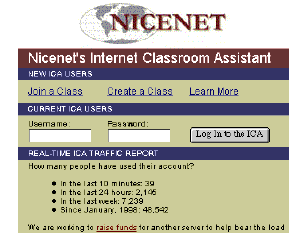
- WebCt---a course management system typically used for university courses.
- Virtual High School---a collaborative project among schools using the virtual school model.
- Quia---tools to create educational resources
- DiscoverySchool.com---a site for teachers, students and parents to create online tools for learning
Network Science and Inquiry Projects
The Internet provided teachers will a tool to engage their students in collaborative inquiry projeccts starting in the late 1980s, and over that time period, the protocols for interesting projects has emerged. You can generate a discussion that focuses on the attributes of science projects on the Net:
- Investigation of "Real Science" and Science-Related Social Issues
- Students-as-Scientists
- Students-as-Citizen-Scientists
- The Role of Data
- Constructivist Learning
- Societal Implications of Science
- Global Learning Community
- Cross-Cultural Understanding
- Pedagogical Shifts
- Collaborative/Cooperative Learning
- The Role of Technology
Inquiry Activity 12.2: Network Science---Exploring Online Projects
In this inquiry, you students will investigate the attributes of four diferent projects, including: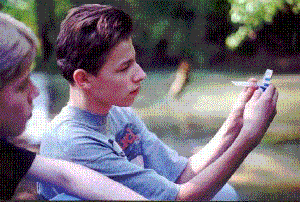
Other project you might want to have your students explore include:
Establishing an Online Classroom
Helping your students see the value in an online course is to use some elements of the online environment in your own course or seminar. Even if you present a one-day seminar, it is advisable to create a web page that summarizes the seminar, and includes the resources you think will help your audience. In a course, a website is essential. There are many online tools that you can use to create an online environment. These are some that we've found useful in our own work:
- Blackboard---a course management system
- Nicenet---a free course management system
- WebCt---a course management system typically used for university courses.
- Virtual High School---a collaborative project among schools using the virtual school model.
- Quia---tools to create educational resources
- DiscoverySchool.com---a site for teachers, students and parents to create online tools for learning
SECTION 2: SCIENCE TEACHER GAZETTE
Science Teachers Talk: How do you use technology (including the Internet) in your science lessons? (Refer to the Companion Website for these discussions)
Seven teachers from three different continents discuss how they use technology in the classroom.
Problems and Extensions
Use one or more of the Problems and Extensions for classroom discussion, or online project work.
Readings
We've identified some key readings on the role of the Internet in science teaching.
On the Web
We've listed a few sites that should provide jumping off points for you and your students as you explore the Internet and science teaching.
